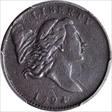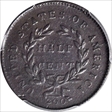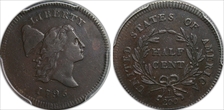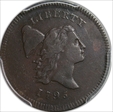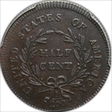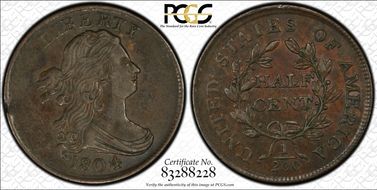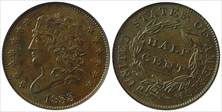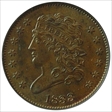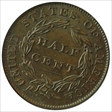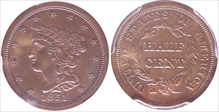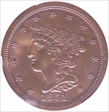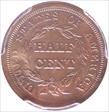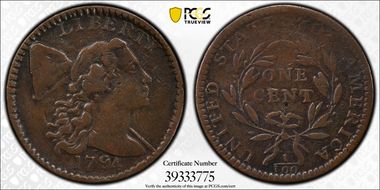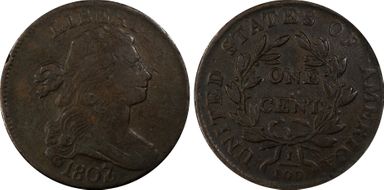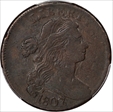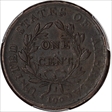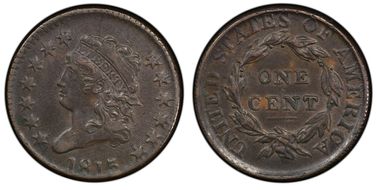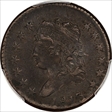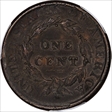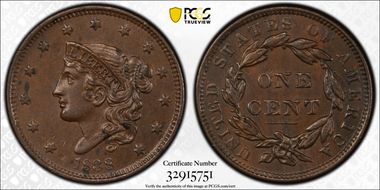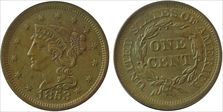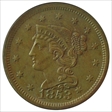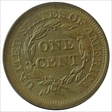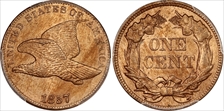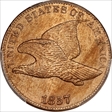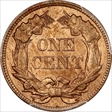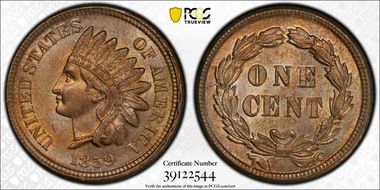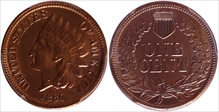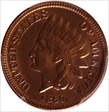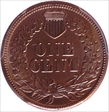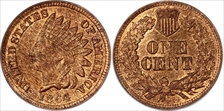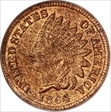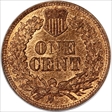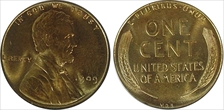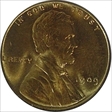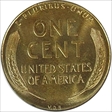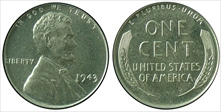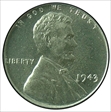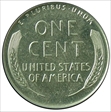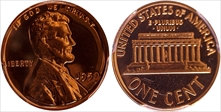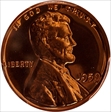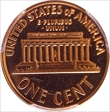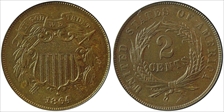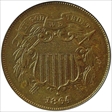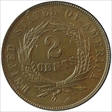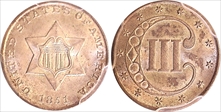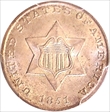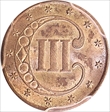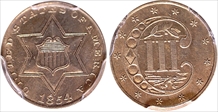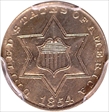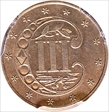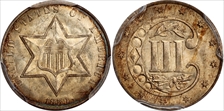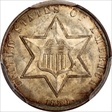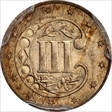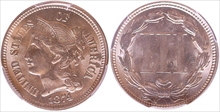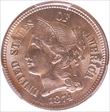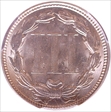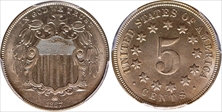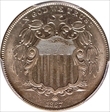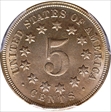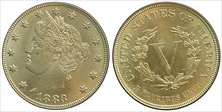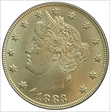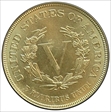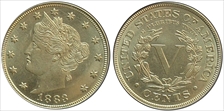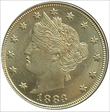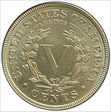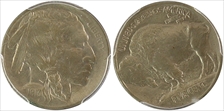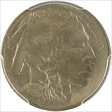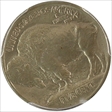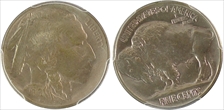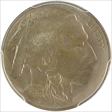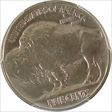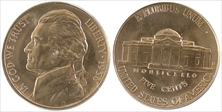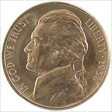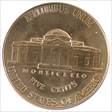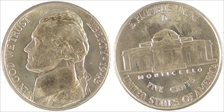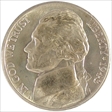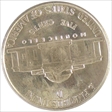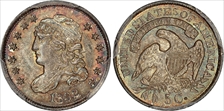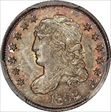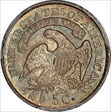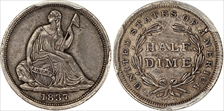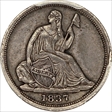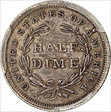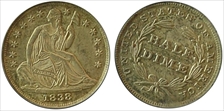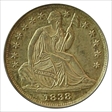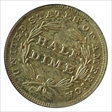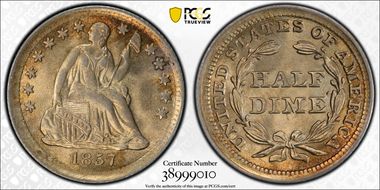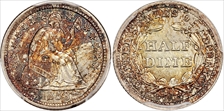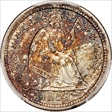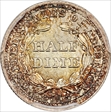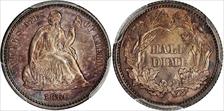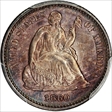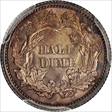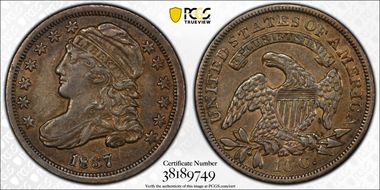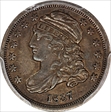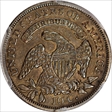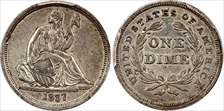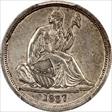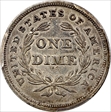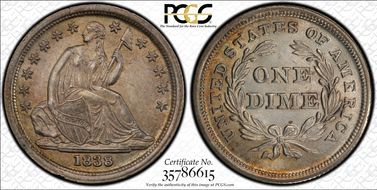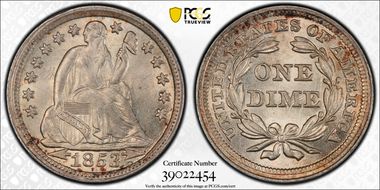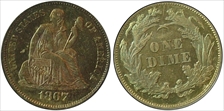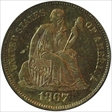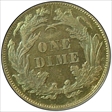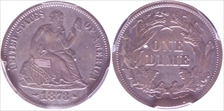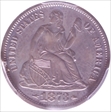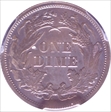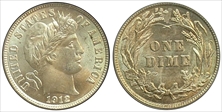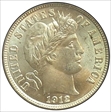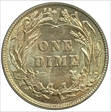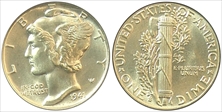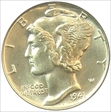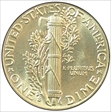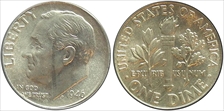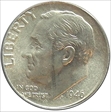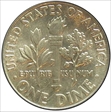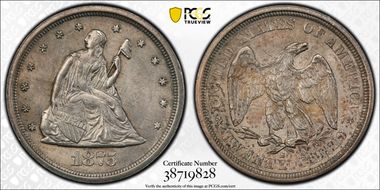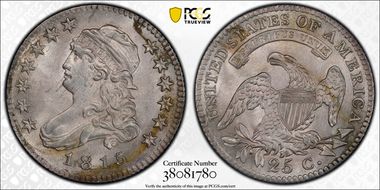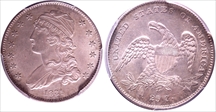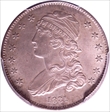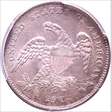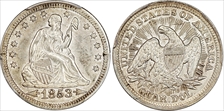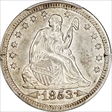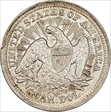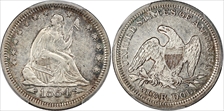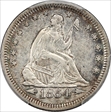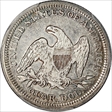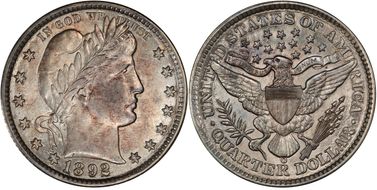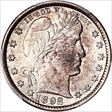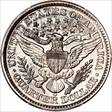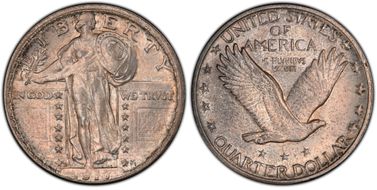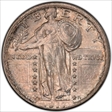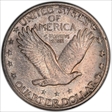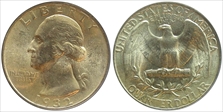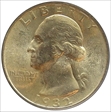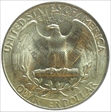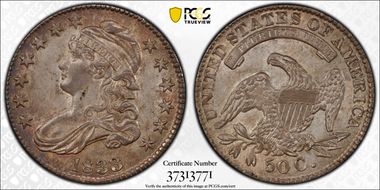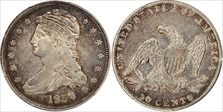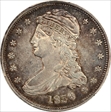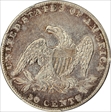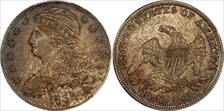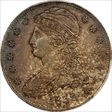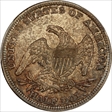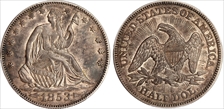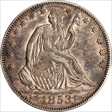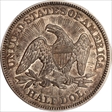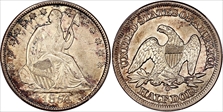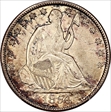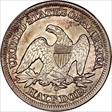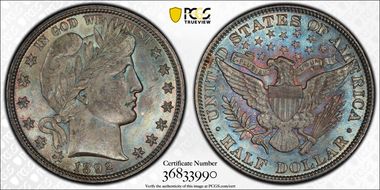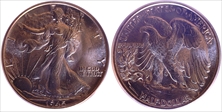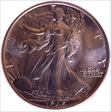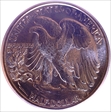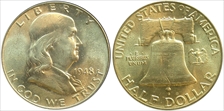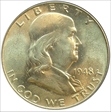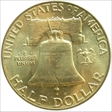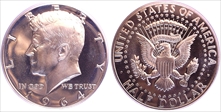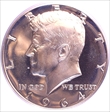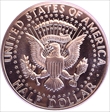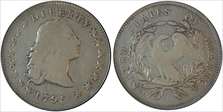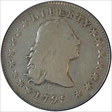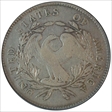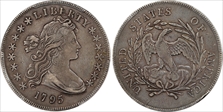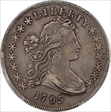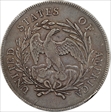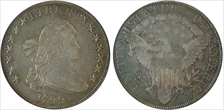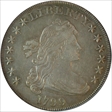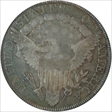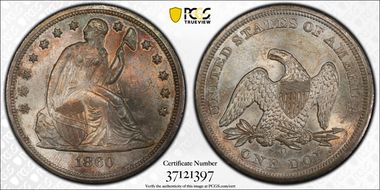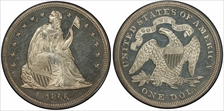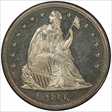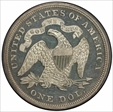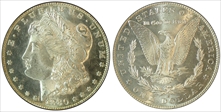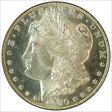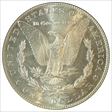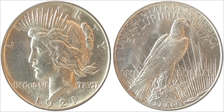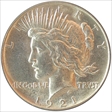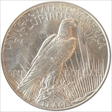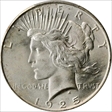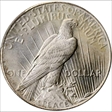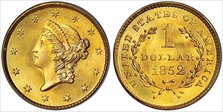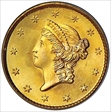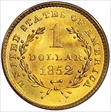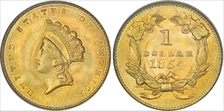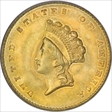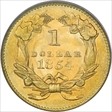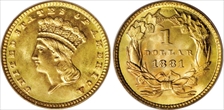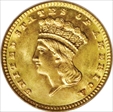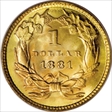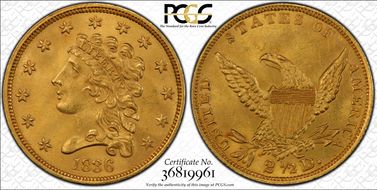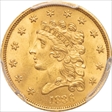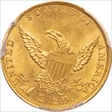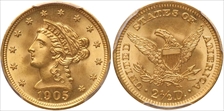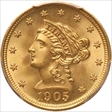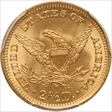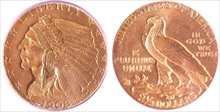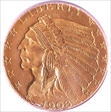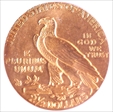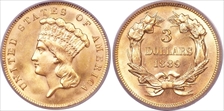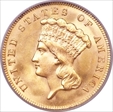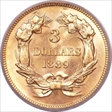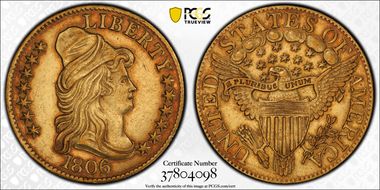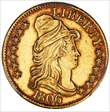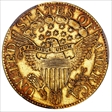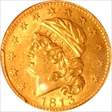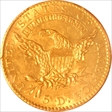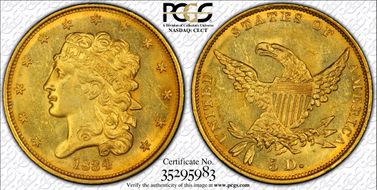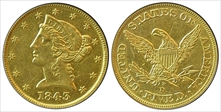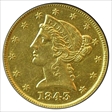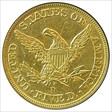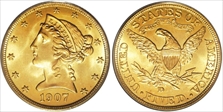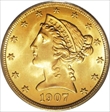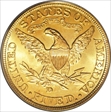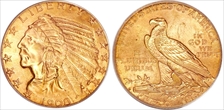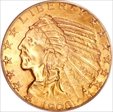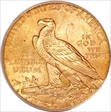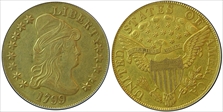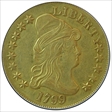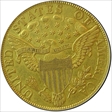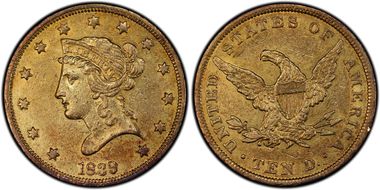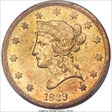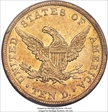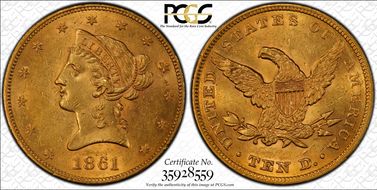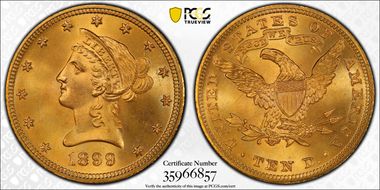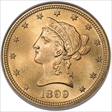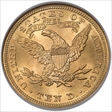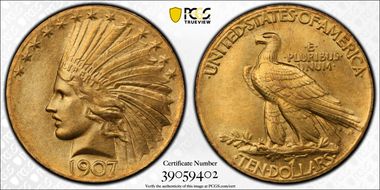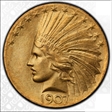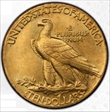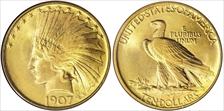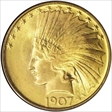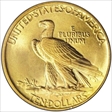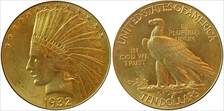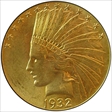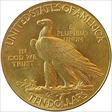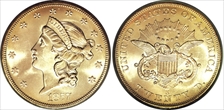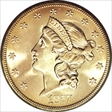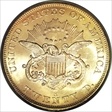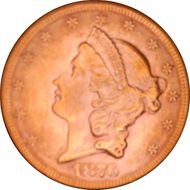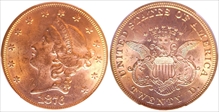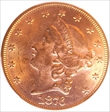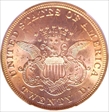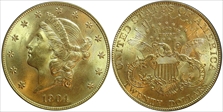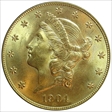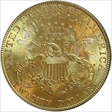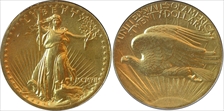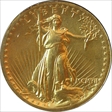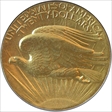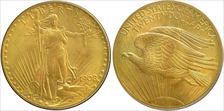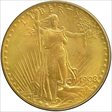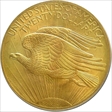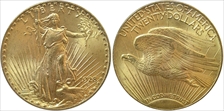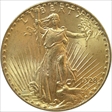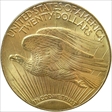The Good Collection 的钱币相册
1794 Liberty Cap Half Cent ex: Dr. James McCallum VF30 { PCGS-4 }. A handsome piece with blended deep copper and medium brown patina on both sides, the latter a bit more pronounced on the reverse. Well centered in strike despite scant denticulation in isolated areas, most devices are boldly defined, and all are discernible. There is softness to the letters LI in LIBERTY and most of those in the words UNITED and CENT. Surfaces show microscopic roughness due to scattered handling marks. Eye-pleasing details of all devices offers a nice example of this early first-year variety. Manley Die State 2.0. C-1a-R3.
1794 Liberty Cap Half Cent ex: Dr. James McCallum VF30 { PCGS-4 }. A handsome piece with blended deep copper and medium brown patina on both sides, the latter a bit more pronounced on the reverse. Well centered in strike despite scant denticulation in isolated areas, most devices are boldly defined, and all are discernible. There is softness to the letters LI in LIBERTY and most of those in the words UNITED and CENT. Surfaces show microscopic roughness due to scattered handling marks. Eye-pleasing details of all devices offers a nice example of this early first-year variety. Manley Die State 2.0. C-1a-R3.
1795 Liberty Cap Half Cent (Plain Edge, No Pole) AU50 { PCGS-4 }. Nice detail on chocolate brown surfaces with nice strike for all devices front and back.
1795 Liberty Cap Half Cent (Plain Edge, No Pole) AU50 { PCGS-4 }. Nice detail on chocolate brown surfaces with nice strike for all devices front and back.
1795 Liberty Cap Half Cent (Plain Edge, No Pole) AU50 { PCGS-4 }. Nice detail on chocolate brown surfaces with nice strike for all devices front and back.
1804 Draped Bust Half Cent (Plain 4 – No Stems) AU53 { PCGS-5 } { CAC } (Aug’2020). Attractive Liberty design with flowing hair and a ribbon, this piece offers nice details with a solid uniform strike. Interesting is the denomination, noted as “HALF CENT” but also as “1/200” on the reverse stating the fractional part of a dollar.
1833 Classic Head Half Cent MS62BN { PCGS-3 } (Nov'2005) Creamy chocolate brown surfaces uniformly cover this very attractive pre-Civil War half-penny with a slight die rotation. In this year Andrew Jackson was sworn in to the presidency of the United States.
1833 Classic Head Half Cent MS62BN { PCGS-3 } (Nov'2005) Creamy chocolate brown surfaces uniformly cover this very attractive pre-Civil War half-penny with a slight die rotation. In this year Andrew Jackson was sworn in to the presidency of the United States.
1833 Classic Head Half Cent MS62BN { PCGS-3 } (Nov'2005) Creamy chocolate brown surfaces uniformly cover this very attractive pre-Civil War half-penny with a slight die rotation. In this year Andrew Jackson was sworn in to the presidency of the United States.
1851 Braided Hair Half Cent MS64BN { PCGS-4 } (Aug’2020). Light steel and olive toning bathes both sides with mint red underneath producing lustrous surfaces for this final variety of the Half-Cent, also referred to as the Coronet Head. There are a pair of tiny, faint marks on the jaw line and left of star 11, hardly notable but they serve to identify.
1851 Braided Hair Half Cent MS64BN { PCGS-4 } (Aug’2020). Light steel and olive toning bathes both sides with mint red underneath producing lustrous surfaces for this final variety of the Half-Cent, also referred to as the Coronet Head. There are a pair of tiny, faint marks on the jaw line and left of star 11, hardly notable but they serve to identify.
1851 Braided Hair Half Cent MS64BN { PCGS-4 } (Aug’2020). Light steel and olive toning bathes both sides with mint red underneath producing lustrous surfaces for this final variety of the Half-Cent, also referred to as the Coronet Head. There are a pair of tiny, faint marks on the jaw line and left of star 11, hardly notable but they serve to identify.
1794 Liberty Cap Cent (S-63) w/ Right Facing Head and Denticle Border VF25 { PCGS-5 }. This late eighteenth century beauty has glossy medium-brown surfaces with undertones of steel-blue. This coin has a 30-degree die rotation. The date is well struck and clearly visible; but on the opposite side there is weakness in the top of the wreath and in particular on the periphery in the word “OF”. The remaining devices are clearly defined. This Sheldon variety has the "Fallen 4" moniker primarily because the "9" appears to be too high. Re-punching of both the "7" and "4" are apparent.
1807/6 Draped Cent (Large 7) VF25 { PCGS-4 } (Aug’2020) Minted during the Jefferson presidency, this copper cent is darkly toned appropriate for its age. The lower part of the overstruck-6 is clearly visible, superseded by a large “7”. The grade offers sufficient details in the hair to complete the image of a young attractive Liberty, and on the reverse there is just a hint of details in the leaves of the wreath.
1807/6 Draped Cent (Large 7) VF25 { PCGS-4 } (Aug’2020) Minted during the Jefferson presidency, this copper cent is darkly toned appropriate for its age. The lower part of the overstruck-6 is clearly visible, superseded by a large “7”. The grade offers sufficient details in the hair to complete the image of a young attractive Liberty, and on the reverse there is just a hint of details in the leaves of the wreath.
1807/6 Draped Cent (Large 7) VF25 { PCGS-4 } (Aug’2020) Minted during the Jefferson presidency, this copper cent is darkly toned appropriate for its age. The lower part of the overstruck-6 is clearly visible, superseded by a large “7”. The grade offers sufficient details in the hair to complete the image of a young attractive Liberty, and on the reverse there is just a hint of details in the leaves of the wreath.
1813 Classic Head Large Cent AU53 ex: D.L. Hansen { PCGS-4 }. This copper piece has smooth well-preserved surfaces and a nice strike for this classic Liberty Capped design. The strike is good and devices nicely rendered. There is a slight 10-degree die rotation.
1813 Classic Head Large Cent AU53 ex: D.L. Hansen { PCGS-4 }. This copper piece has smooth well-preserved surfaces and a nice strike for this classic Liberty Capped design. The strike is good and devices nicely rendered. There is a slight 10-degree die rotation.
1813 Classic Head Large Cent AU53 ex: D.L. Hansen { PCGS-4 }. This copper piece has smooth well-preserved surfaces and a nice strike for this classic Liberty Capped design. The strike is good and devices nicely rendered. There is a slight 10-degree die rotation.
1838 Coronet Head Cent (Newcomb-9) ex: Twin Leaf Collection MS61BN { PCGS-4 } ( Aug’2020 ). This large copper cent introduces Miss Liberty with a more regal look sporting “LIBERTY” in her coronet.
1853 Braided Hair Large Cent MS64BN { PCGS-3 } (May'2006) This chocolate brown large cent, struck slightly off-center, offers nice details in the devices.
1853 Braided Hair Large Cent MS64BN { PCGS-3 } (May'2006) This chocolate brown large cent, struck slightly off-center, offers nice details in the devices.
1853 Braided Hair Large Cent MS64BN { PCGS-3 } (May'2006) This chocolate brown large cent, struck slightly off-center, offers nice details in the devices.
1857 Flying Eagle Small Cent MS64 { PCGS-4 } { CAC | Eagle Eye Photo Seal }. This attractive olive-toned flyer features well-struck devices highlighted by good feather definition and well struck eagle head and eye. The wing-tip is well defined and clearly discernable. This new smaller size for the one-cent piece would establish the standard moving forward into the 21st-century.
1857 Flying Eagle Small Cent MS64 { PCGS-4 } { CAC | Eagle Eye Photo Seal }. This attractive olive-toned flyer features well-struck devices highlighted by good feather definition and well struck eagle head and eye. The wing-tip is well defined and clearly discernable. This new smaller size for the one-cent piece would establish the standard moving forward into the 21st-century.
1857 Flying Eagle Small Cent MS64 { PCGS-4 } { CAC | Eagle Eye Photo Seal }. This attractive olive-toned flyer features well-struck devices highlighted by good feather definition and well struck eagle head and eye. The wing-tip is well defined and clearly discernable. This new smaller size for the one-cent piece would establish the standard moving forward into the 21st-century.
1859 Indian Cent MS64 { PCGS-5 } { CAC } (Aug’2020). This first-year pre-Civil War issue and one-year variety without a shield on the reverse has a nicely struck headdress with good feather definition, a bold “LIBERTY” and four distinct diamonds in the ribbon.
1860 Indian Head Cent MS62 { PCGS-4 } ( Jul'2020) This pre-Civil War Indian Cent is just the second year of the series; AND the first featuring a US shield between the wreath on the reverse. Struck in copper-nickel the olive patina uniformly covers this coin now struck over eight score years ago.
1860 Indian Head Cent MS62 { PCGS-4 } ( Jul'2020) This pre-Civil War Indian Cent is just the second year of the series; AND the first featuring a US shield between the wreath on the reverse. Struck in copper-nickel the olive patina uniformly covers this coin now struck over eight score years ago.
1860 Indian Head Cent MS62 { PCGS-4 } ( Jul'2020) This pre-Civil War Indian Cent is just the second year of the series; AND the first featuring a US shield between the wreath on the reverse. Struck in copper-nickel the olive patina uniformly covers this coin now struck over eight score years ago.
1864 Indian Head Bronze Cent MS64RB { PCGS-3 } { CAC | Eagle Eye Photo Seal } (Aug'2020) This well struck bronze cent is they first year of issue for this variation which would remain unchanged for the next forty-five years. Attractively toned, the fields offer ample reddish copper highlights that offset the handsomely darkened devices. The four diamonds on the ribbon are well defined and details extend to the feather-tips.
1864 Indian Head Bronze Cent MS64RB { PCGS-3 } { CAC | Eagle Eye Photo Seal } (Aug'2020) This well struck bronze cent is they first year of issue for this variation which would remain unchanged for the next forty-five years. Attractively toned, the fields offer ample reddish copper highlights that offset the handsomely darkened devices. The four diamonds on the ribbon are well defined and details extend to the feather-tips.
1864 Indian Head Bronze Cent MS64RB { PCGS-3 } { CAC | Eagle Eye Photo Seal } (Aug'2020) This well struck bronze cent is they first year of issue for this variation which would remain unchanged for the next forty-five years. Attractively toned, the fields offer ample reddish copper highlights that offset the handsomely darkened devices. The four diamonds on the ribbon are well defined and details extend to the feather-tips.
1909 VDB Lincoln Cent MS65RD { PCGS-3 } (Apr'2009) Brilliant red mint-fresh luster and satiny fields adorn both sides of this first year Lincoln Cent which includes the designer's initials on the reverse at 6 o'clock. Public outcry derided the "imposing" initials, and they were removed quickly, and most initial year coins do not contain them.
1909 VDB Lincoln Cent MS65RD { PCGS-3 } (Apr'2009) Brilliant red mint-fresh luster and satiny fields adorn both sides of this first year Lincoln Cent which includes the designer's initials on the reverse at 6 o'clock. Public outcry derided the "imposing" initials, and they were removed quickly, and most initial year coins do not contain them.
1909 VDB Lincoln Cent MS65RD { PCGS-3 } (Apr'2009) Brilliant red mint-fresh luster and satiny fields adorn both sides of this first year Lincoln Cent which includes the designer's initials on the reverse at 6 o'clock. Public outcry derided the "imposing" initials, and they were removed quickly, and most initial year coins do not contain them.
1943 Lincoln Steel Cent MS67 { PCGS-3 } (Nov'2005) This gem cent is a nice high-end clean mint-state Philly-steel (for the type collection). A pleasing mint-state patina has muted the mint-fresh shiny surfaces.
1943 Lincoln Steel Cent MS67 { PCGS-3 } (Nov'2005) This gem cent is a nice high-end clean mint-state Philly-steel (for the type collection). A pleasing mint-state patina has muted the mint-fresh shiny surfaces.
1943 Lincoln Steel Cent MS67 { PCGS-3 } (Nov'2005) This gem cent is a nice high-end clean mint-state Philly-steel (for the type collection). A pleasing mint-state patina has muted the mint-fresh shiny surfaces.
1959 Lincoln Memorial Cent PR67RD { PCGS-4 } This beautifully struck mint-fresh red has deeply reflective mirrors presenting for the first time the Lincoln Memorial on the reverse.
1959 Lincoln Memorial Cent PR67RD { PCGS-4 } This beautifully struck mint-fresh red has deeply reflective mirrors presenting for the first time the Lincoln Memorial on the reverse.
1959 Lincoln Memorial Cent PR67RD { PCGS-4 } This beautifully struck mint-fresh red has deeply reflective mirrors presenting for the first time the Lincoln Memorial on the reverse.
1864 Two Cent Large Motto MS64RB { PCGS-3 } (Nov'2005) Just the faintest glimmer of red on this mostly brown two-pence, complete with the motto "In God We Trust". This was the first coin to bear this motto.
1864 Two Cent Large Motto MS64RB { PCGS-3 } (Nov'2005) Just the faintest glimmer of red on this mostly brown two-pence, complete with the motto "In God We Trust". This was the first coin to bear this motto.
1864 Two Cent Large Motto MS64RB { PCGS-3 } (Nov'2005) Just the faintest glimmer of red on this mostly brown two-pence, complete with the motto "In God We Trust". This was the first coin to bear this motto.
1851 Three Cent Silver Type 1 MS65 { PCGS-4 } (Aug'2020). This introductory year for the "trime" found this tiny coin just 75% silver being placed into circulation featuring a star and shield on the obverse and a Roman Numeral "III" on the reverse. The stylized "C" suggests "CENTS". Later designated as "Type 1", its distinguishing characteristic is the single border of the star from the field; also there are no olive sprig or bundle of arrows above and below the "III". Old-silver toning has diminished the luster some while complimenting the age of the devices.
1851 Three Cent Silver Type 1 MS65 { PCGS-4 } (Aug'2020). This introductory year for the "trime" found this tiny coin just 75% silver being placed into circulation featuring a star and shield on the obverse and a Roman Numeral "III" on the reverse. The stylized "C" suggests "CENTS". Later designated as "Type 1", its distinguishing characteristic is the single border of the star from the field; also there are no olive sprig or bundle of arrows above and below the "III". Old-silver toning has diminished the luster some while complimenting the age of the devices.
1851 Three Cent Silver Type 1 MS65 { PCGS-4 } (Aug'2020). This introductory year for the "trime" found this tiny coin just 75% silver being placed into circulation featuring a star and shield on the obverse and a Roman Numeral "III" on the reverse. The stylized "C" suggests "CENTS". Later designated as "Type 1", its distinguishing characteristic is the single border of the star from the field; also there are no olive sprig or bundle of arrows above and below the "III". Old-silver toning has diminished the luster some while complimenting the age of the devices.
1854 Three Cent Silver Type 2 MS63 { PCGS-4 } (AUG'2020). This second of three designs for a never popular coin upped the silver content to that of other US Silver coins, yielding an even lighter coin than the Type 1. Introducing a laurel above the Roman Numeral "III" and some arrows below it. the large ornate "C" continued to suggest "Cents".
1854 Three Cent Silver Type 2 MS63 { PCGS-4 } (AUG'2020). This second of three designs for a never popular coin upped the silver content to that of other US Silver coins, yielding an even lighter coin than the Type 1. Introducing a laurel above the Roman Numeral "III" and some arrows below it. the large ornate "C" continued to suggest "Cents".
1854 Three Cent Silver Type 2 MS63 { PCGS-4 } (AUG'2020). This second of three designs for a never popular coin upped the silver content to that of other US Silver coins, yielding an even lighter coin than the Type 1. Introducing a laurel above the Roman Numeral "III" and some arrows below it. the large ornate "C" continued to suggest "Cents".
1859 Three Cent Silver (Type 3) MS66 { PCGS-4 } (Aug'2020). This solidly struck PQ gem offers a solid strike and well-defined devices. The difference in the design for the three different types of the series are the number of distinct lines that form the border of the star. This Type-3 first-year-issue has two such lines (as opposed to the Type-2 that has three... go figure).
1859 Three Cent Silver (Type 3) MS66 { PCGS-4 } (Aug'2020). This solidly struck PQ gem offers a solid strike and well-defined devices. The difference in the design for the three different types of the series are the number of distinct lines that form the border of the star. This Type-3 first-year-issue has two such lines (as opposed to the Type-2 that has three... go figure).
1859 Three Cent Silver (Type 3) MS66 { PCGS-4 } (Aug'2020). This solidly struck PQ gem offers a solid strike and well-defined devices. The difference in the design for the three different types of the series are the number of distinct lines that form the border of the star. This Type-3 first-year-issue has two such lines (as opposed to the Type-2 that has three... go figure).
1874 Three Cent Nickel MS63 {PCGS-4} (Aug'2020). This choice tone-free specimen offers a bold strike with nice details in Liberty's hair, on the leaves of the wreath and in all of the parallel lines running the length of all three Roman Numerals.
1874 Three Cent Nickel MS63 {PCGS-4} (Aug'2020). This choice tone-free specimen offers a bold strike with nice details in Liberty's hair, on the leaves of the wreath and in all of the parallel lines running the length of all three Roman Numerals.
1874 Three Cent Nickel MS63 {PCGS-4} (Aug'2020). This choice tone-free specimen offers a bold strike with nice details in Liberty's hair, on the leaves of the wreath and in all of the parallel lines running the length of all three Roman Numerals.
1866 Liberty Shield Nickel (with Rays) MS65 { PCGS-5 } { CAC } (Aug’2020). This nicely struck nickel features the first-year design including rays about the shield presenting an over-crowded design fraught with production issues.
1867 Shield Nickel (No Rays) { PCGS-4 } (Aug'2020). In the second year of this series, the "rays" are removed simplifying the design and enhancing the overall eye appeal. Nice uniform nickel toning covers the piece and the strike is solid giving good detail for all of the lines in the shield.
1867 Shield Nickel (No Rays) { PCGS-4 } (Aug'2020). In the second year of this series, the "rays" are removed simplifying the design and enhancing the overall eye appeal. Nice uniform nickel toning covers the piece and the strike is solid giving good detail for all of the lines in the shield.
1867 Shield Nickel (No Rays) { PCGS-4 } (Aug'2020). In the second year of this series, the "rays" are removed simplifying the design and enhancing the overall eye appeal. Nice uniform nickel toning covers the piece and the strike is solid giving good detail for all of the lines in the shield.
1883 Liberty Head Nickel No CENTS MS65 { PCGS-2 } (Mar'2009) Nice luster on this OGH gem compliments a strike which is solid on this first-year issue original variety sans "CENTS". Some unscrupulous entrepreneurs took to gold-plating these coins and then using them to buy a couple cents worth of merchandise, hoping to get nearly $5 in change. This was the only US coin to be minted without a denomination, a situation which was quickly remedied.
1883 Liberty Head Nickel No CENTS MS65 { PCGS-2 } (Mar'2009) Nice luster on this OGH gem compliments a strike which is solid on this first-year issue original variety sans "CENTS". Some unscrupulous entrepreneurs took to gold-plating these coins and then using them to buy a couple cents worth of merchandise, hoping to get nearly $5 in change. This was the only US coin to be minted without a denomination, a situation which was quickly remedied.
1883 Liberty Head Nickel No CENTS MS65 { PCGS-2 } (Mar'2009) Nice luster on this OGH gem compliments a strike which is solid on this first-year issue original variety sans "CENTS". Some unscrupulous entrepreneurs took to gold-plating these coins and then using them to buy a couple cents worth of merchandise, hoping to get nearly $5 in change. This was the only US coin to be minted without a denomination, a situation which was quickly remedied.
1883 Liberty Head Nickel With CENTS MS64 { PCGS-3 } (Feb'2009) This first year design modification has nice luster, no serious marks, and a die-break through the upper stars on the obverse. "CENTS" was added when con-men gold plated the No Cents variety with gold and tried to pass them off as half eagles.
1883 Liberty Head Nickel With CENTS MS64 { PCGS-3 } (Feb'2009) This first year design modification has nice luster, no serious marks, and a die-break through the upper stars on the obverse. "CENTS" was added when con-men gold plated the No Cents variety with gold and tried to pass them off as half eagles.
1883 Liberty Head Nickel With CENTS MS64 { PCGS-3 } (Feb'2009) This first year design modification has nice luster, no serious marks, and a die-break through the upper stars on the obverse. "CENTS" was added when con-men gold plated the No Cents variety with gold and tried to pass them off as half eagles.
1913 Buffalo Nickel Type 1 MS64 { PCGS-4 } (Apr'2013) A solid strike has good details on both sides, a full horn and clear definition of the buffalo's tail. This variety, with the buffalo standing on the mound was the initial design, found to be lacking in that the denomination as feared to be the first thing to wear off, and so the second variety was introduced this same year to provide it better protection. This is the most common of the two varieties (from all mints). The reverse also has a thirty degree die rotation.
1913 Buffalo Nickel Type 1 MS64 { PCGS-4 } (Apr'2013) A solid strike has good details on both sides, a full horn and clear definition of the buffalo's tail. This variety, with the buffalo standing on the mound was the initial design, found to be lacking in that the denomination as feared to be the first thing to wear off, and so the second variety was introduced this same year to provide it better protection. This is the most common of the two varieties (from all mints). The reverse also has a thirty degree die rotation.
1913 Buffalo Nickel Type 1 MS64 { PCGS-4 } (Apr'2013) A solid strike has good details on both sides, a full horn and clear definition of the buffalo's tail. This variety, with the buffalo standing on the mound was the initial design, found to be lacking in that the denomination as feared to be the first thing to wear off, and so the second variety was introduced this same year to provide it better protection. This is the most common of the two varieties (from all mints). The reverse also has a thirty degree die rotation.
1913 Buffalo Nickel Type 2 MS64 { PCGS-4 } (Apr'2013) There are some attractive underlying toning visible on both sides, including rose, gold, cobalt blue and emerald green. There is also considerable luster from the reverse, which is also rotated about twenty degrees. The design change occurred later in the year, making this the rarer of the the two types from all three mints.
1913 Buffalo Nickel Type 2 MS64 { PCGS-4 } (Apr'2013) There are some attractive underlying toning visible on both sides, including rose, gold, cobalt blue and emerald green. There is also considerable luster from the reverse, which is also rotated about twenty degrees. The design change occurred later in the year, making this the rarer of the the two types from all three mints.
1913 Buffalo Nickel Type 2 MS64 { PCGS-4 } (Apr'2013) There are some attractive underlying toning visible on both sides, including rose, gold, cobalt blue and emerald green. There is also considerable luster from the reverse, which is also rotated about twenty degrees. The design change occurred later in the year, making this the rarer of the the two types from all three mints.
1938-D Jefferson Nickel MS65 { PCGS-3 } (Apr'2013) Pleasing nickel color blankets both sides of this first-year mid-year replacement of the popular Buffalo Nickel. Jefferson was the third American/Statesman to be honored on regular issue coinage of the United States.
1938-D Jefferson Nickel MS65 { PCGS-3 } (Apr'2013) Pleasing nickel color blankets both sides of this first-year mid-year replacement of the popular Buffalo Nickel. Jefferson was the third American/Statesman to be honored on regular issue coinage of the United States.
1938-D Jefferson Nickel MS65 { PCGS-3 } (Apr'2013) Pleasing nickel color blankets both sides of this first-year mid-year replacement of the popular Buffalo Nickel. Jefferson was the third American/Statesman to be honored on regular issue coinage of the United States.
1943-D Jefferson Nickel MS66FS { PCGS-3 } (Apr'2013) Beautiful lustrous gunmetal gray surfaces are augmented by the subtle underlying pastel colors of cobalt blue, lilac, gold, rose and fuchsia. This wartime gem features the large "D" over the dome and the steps of Monticello are each clearly delineated. In the face of rationing and support for the war effort, nickel and copper were too precious to waste on making money, so a longtime favorite silver, not used in this denomination since the half-dime, was again pressed into service.
1943-D Jefferson Nickel MS66FS { PCGS-3 } (Apr'2013) Beautiful lustrous gunmetal gray surfaces are augmented by the subtle underlying pastel colors of cobalt blue, lilac, gold, rose and fuchsia. This wartime gem features the large "D" over the dome and the steps of Monticello are each clearly delineated. In the face of rationing and support for the war effort, nickel and copper were too precious to waste on making money, so a longtime favorite silver, not used in this denomination since the half-dime, was again pressed into service.
1943-D Jefferson Nickel MS66FS { PCGS-3 } (Apr'2013) Beautiful lustrous gunmetal gray surfaces are augmented by the subtle underlying pastel colors of cobalt blue, lilac, gold, rose and fuchsia. This wartime gem features the large "D" over the dome and the steps of Monticello are each clearly delineated. In the face of rationing and support for the war effort, nickel and copper were too precious to waste on making money, so a longtime favorite silver, not used in this denomination since the half-dime, was again pressed into service.
1832 Capped Bust Half Dime MS64+ { PCGS-4 } { CAC } ( Aug’2020 ). Pretty multi-colored toning features light pastel hues of gold, orange, rose, magenta, lilac, aqua and green. Nice strike on this early classic looking half dime with an eagle on the reverse.
1832 Capped Bust Half Dime MS64+ { PCGS-4 } { CAC } ( Aug’2020 ). Pretty multi-colored toning features light pastel hues of gold, orange, rose, magenta, lilac, aqua and green. Nice strike on this early classic looking half dime with an eagle on the reverse.
1832 Capped Bust Half Dime MS64+ { PCGS-4 } { CAC } ( Aug’2020 ). Pretty multi-colored toning features light pastel hues of gold, orange, rose, magenta, lilac, aqua and green. Nice strike on this early classic looking half dime with an eagle on the reverse.
1837 Seated Liberty Half Dime (No Stars, Small Date) AU50 { PCGS-4 } ( AUG’2020). Very appealing silver toning provides dark outlining of devices. Notice the absence of stars in the obverse field, and the left arm free of drapery.
1837 Seated Liberty Half Dime (No Stars, Small Date) AU50 { PCGS-4 } ( AUG’2020). Very appealing silver toning provides dark outlining of devices. Notice the absence of stars in the obverse field, and the left arm free of drapery.
1837 Seated Liberty Half Dime (No Stars, Small Date) AU50 { PCGS-4 } ( AUG’2020). Very appealing silver toning provides dark outlining of devices. Notice the absence of stars in the obverse field, and the left arm free of drapery.
1838 Half Dime No Drapery MS63 { PCGS-3 } (Nov'2005) With somewhat mottled "old-silver" patina, this tiny silver piece has a decent strike and a slight die rotation. Martin Van Buren was president when this piece was issued.
1838 Half Dime No Drapery MS63 { PCGS-3 } (Nov'2005) With somewhat mottled "old-silver" patina, this tiny silver piece has a decent strike and a slight die rotation. Martin Van Buren was president when this piece was issued.
1838 Half Dime No Drapery MS63 { PCGS-3 } (Nov'2005) With somewhat mottled "old-silver" patina, this tiny silver piece has a decent strike and a slight die rotation. Martin Van Buren was president when this piece was issued.
1857 Seated Liberty Half Dime MS65 { PCGS-5 } { CAC } (Sep’2020). Champagne toning covers this half dime gem with some darker harvest coloring in the stars. This nicely struck coin offers nice detail in the devices and ample eye-pleasing luster.
1853 Seated Liberty Half Dime (Arrows) MS63 { PCGS-4 } ( AUG’2020 ). Gorgeous autumn colors of gold, rose, magenta and violet attract attention on this first year design with arrows by the date, denoting the change in silver content for this issue.
1853 Seated Liberty Half Dime (Arrows) MS63 { PCGS-4 } ( AUG’2020 ). Gorgeous autumn colors of gold, rose, magenta and violet attract attention on this first year design with arrows by the date, denoting the change in silver content for this issue.
1853 Seated Liberty Half Dime (Arrows) MS63 { PCGS-4 } ( AUG’2020 ). Gorgeous autumn colors of gold, rose, magenta and violet attract attention on this first year design with arrows by the date, denoting the change in silver content for this issue.
1860 Seated Liberty Half Dime MS66 ex: D.L. Hansen { PCGS-4 } ( Aug’2020 ). This lustrous gem has superb overall eye appeal. Pretty light golden centers are offset with lavender and rose tints around the rims. This is the first year of the new legend-obverse design type with UNITED STATES OF AMERICA surrounding the seated Liberty..
1860 Seated Liberty Half Dime MS66 ex: D.L. Hansen { PCGS-4 } ( Aug’2020 ). This lustrous gem has superb overall eye appeal. Pretty light golden centers are offset with lavender and rose tints around the rims. This is the first year of the new legend-obverse design type with UNITED STATES OF AMERICA surrounding the seated Liberty..
1860 Seated Liberty Half Dime MS66 ex: D.L. Hansen { PCGS-4 } ( Aug’2020 ). This lustrous gem has superb overall eye appeal. Pretty light golden centers are offset with lavender and rose tints around the rims. This is the first year of the new legend-obverse design type with UNITED STATES OF AMERICA surrounding the seated Liberty..
1837 Capped Bust Dime AU53 { PCGS-5 } { CAC }. Attractive old-silver toning evenly blankets fields and devices to emphasize the age of this early Capped Bust dime. There is just a hint of wear on the feathers and hair curls.
1837 Capped Bust Dime AU53 { PCGS-5 } { CAC }. Attractive old-silver toning evenly blankets fields and devices to emphasize the age of this early Capped Bust dime. There is just a hint of wear on the feathers and hair curls.
1837 Capped Bust Dime AU53 { PCGS-5 } { CAC }. Attractive old-silver toning evenly blankets fields and devices to emphasize the age of this early Capped Bust dime. There is just a hint of wear on the feathers and hair curls.
1837 Seated Liberty Dime ( No Stars, Large Date ) AU50 { PCGS-4 } ( Sep’2020). This classic coin features a nice old-silver patina of gun-metal gray on this variety without stars in the obverse field about Miss Liberty. This specimen includes a 15-degree die rotation.
1837 Seated Liberty Dime ( No Stars, Large Date ) AU50 { PCGS-4 } ( Sep’2020). This classic coin features a nice old-silver patina of gun-metal gray on this variety without stars in the obverse field about Miss Liberty. This specimen includes a 15-degree die rotation.
1837 Seated Liberty Dime ( No Stars, Large Date ) AU50 { PCGS-4 } ( Sep’2020). This classic coin features a nice old-silver patina of gun-metal gray on this variety without stars in the obverse field about Miss Liberty. This specimen includes a 15-degree die rotation.
1938 Seated Liberty Dime ( Large Stars, No Drapery ) { PCGS-4 } { CAC } (Sep'2020). Choice example of this first year issue with large stars and no drapery is well-struck and attractively toned.
1859 Seated Liberty Dime MS61 { PCGS-5 } (Sep’2020). Attractive old-silver toning graces this classic design. Devices are nicely complimented with natural toning on this pre-Civil War specimen.
1853 Seated Liberty Dime (Arrows) MS65 { PCGS-5 }. The arrows by the date of this short-lived variety denotes the change in silver content for this gem dime that shows some orange and rust toning in the periphery and denticles. The strike is good and the fields pristine with ample original mint luster.
1867 Seated Liberty Dime PR64 { PCGS-3 } (Jun'1998) This was one of my "bucket coins", a "life-time goal" to acquire before I kick the bucket, that I started looking for when I was twelve. Business strikes have an extremely low mintage and my early attempts to find one with the help of a local dealer all failed; so, I eventually had to settle for proof. This piece has colorful toning with vivid turquoise on the reverse that the photo does not do justice..
1867 Seated Liberty Dime PR64 { PCGS-3 } (Jun'1998) This was one of my "bucket coins", a "life-time goal" to acquire before I kick the bucket, that I started looking for when I was twelve. Business strikes have an extremely low mintage and my early attempts to find one with the help of a local dealer all failed; so, I eventually had to settle for proof. This piece has colorful toning with vivid turquoise on the reverse that the photo does not do justice..
1867 Seated Liberty Dime PR64 { PCGS-3 } (Jun'1998) This was one of my "bucket coins", a "life-time goal" to acquire before I kick the bucket, that I started looking for when I was twelve. Business strikes have an extremely low mintage and my early attempts to find one with the help of a local dealer all failed; so, I eventually had to settle for proof. This piece has colorful toning with vivid turquoise on the reverse that the photo does not do justice..
1873 Seated Liberty Dime (Arrows) PR64 { PCGS-4 } (Sep’2020). This nicely struck proof specimen shimmers with its iridescent aqua undertones and gun-metal gray toning. This brief variety features arrows by the date marking a reduction in silver content and the legend "UNITED STATES OF AMERICA" borders the upper perimeter of the obverse.
1873 Seated Liberty Dime (Arrows) PR64 { PCGS-4 } (Sep’2020). This nicely struck proof specimen shimmers with its iridescent aqua undertones and gun-metal gray toning. This brief variety features arrows by the date marking a reduction in silver content and the legend "UNITED STATES OF AMERICA" borders the upper perimeter of the obverse.
1873 Seated Liberty Dime (Arrows) PR64 { PCGS-4 } (Sep’2020). This nicely struck proof specimen shimmers with its iridescent aqua undertones and gun-metal gray toning. This brief variety features arrows by the date marking a reduction in silver content and the legend "UNITED STATES OF AMERICA" borders the upper perimeter of the obverse.
1912 Barber Dime MS64 { PCGS-3 } (Dec'2007) Natural silver toning on this well struck early twentieth century dime are complimented nicely by luster from this mint-fresh silver beauty, from the same year that the HMS Titanic went to the bottom of the Atlantic.
1912 Barber Dime MS64 { PCGS-3 } (Dec'2007) Natural silver toning on this well struck early twentieth century dime are complimented nicely by luster from this mint-fresh silver beauty, from the same year that the HMS Titanic went to the bottom of the Atlantic.
1912 Barber Dime MS64 { PCGS-3 } (Dec'2007) Natural silver toning on this well struck early twentieth century dime are complimented nicely by luster from this mint-fresh silver beauty, from the same year that the HMS Titanic went to the bottom of the Atlantic.
1941-S Mercury Dime MS67FB { PCGS-3 } (Aug'2005) Great silver luster shines off of this nicely struck gem with full separation of all bands. This gem was struck during the year that the United States entered World War II.
1941-S Mercury Dime MS67FB { PCGS-3 } (Aug'2005) Great silver luster shines off of this nicely struck gem with full separation of all bands. This gem was struck during the year that the United States entered World War II.
1941-S Mercury Dime MS67FB { PCGS-3 } (Aug'2005) Great silver luster shines off of this nicely struck gem with full separation of all bands. This gem was struck during the year that the United States entered World War II.
1946 Roosevelt Dime MS65FB { PCGS-3 } Ex: Omaha Bank Hoard (Mar'2009) Nice even un-toned silver luster on this "Full Band" designated gem offers up an eye appealing first year issue. Multiple die etching lines appear on this FYI early die state obverse.
1946 Roosevelt Dime MS65FB { PCGS-3 } Ex: Omaha Bank Hoard (Mar'2009) Nice even un-toned silver luster on this "Full Band" designated gem offers up an eye appealing first year issue. Multiple die etching lines appear on this FYI early die state obverse.
1946 Roosevelt Dime MS65FB { PCGS-3 } Ex: Omaha Bank Hoard (Mar'2009) Nice even un-toned silver luster on this "Full Band" designated gem offers up an eye appealing first year issue. Multiple die etching lines appear on this FYI early die state obverse.
1875-S Twenty Cent MS62 { PCGS-5 } (Aug'2020). The "old-silver" toning on this first-year issue from the San Francisco mint compliments the classic design for this short-lived series. Over one million coins of this denomination were struck in California this year, far out-pacing other mints and other years.
1815 Capped Bust Quarter ex: D.L. Hansen MS63 { PCGS-4 }. This coin is a handsome mint state example for this desirable first year of type with boldly struck surfaces featuring eye-pleasing rose-grey patina showing splashes of olive toning throughout.
1931 Capped Bust Quarter (Small Letters) MS62 { PCGS-5 } { CAC }. Attractive classic devices are well struck and details are well defined.
1931 Capped Bust Quarter (Small Letters) MS62 { PCGS-5 } { CAC }. Attractive classic devices are well struck and details are well defined.
1931 Capped Bust Quarter (Small Letters) MS62 { PCGS-5 } { CAC }. Attractive classic devices are well struck and details are well defined.
1853 Seated Liberty Quarter ( Arrows & Rays ) MS62 { PCGS-4 } { CAC } ( Sep’2020 ). This interesting variety features arrows by the date indicating a weight change in silver content, while the rays were dropped from the design after this first year appearance due to wear issues on the reverse. This piece offers nice mint luster.
1853 Seated Liberty Quarter ( Arrows & Rays ) MS62 { PCGS-4 } { CAC } ( Sep’2020 ). This interesting variety features arrows by the date indicating a weight change in silver content, while the rays were dropped from the design after this first year appearance due to wear issues on the reverse. This piece offers nice mint luster.
1853 Seated Liberty Quarter ( Arrows & Rays ) MS62 { PCGS-4 } { CAC } ( Sep’2020 ). This interesting variety features arrows by the date indicating a weight change in silver content, while the rays were dropped from the design after this first year appearance due to wear issues on the reverse. This piece offers nice mint luster.
1854 Seated Liberty Quarter (with Arrows) XF45 { PCGS-4 }. Well struck devices and clean fields presents a mid-century example of this quarter, annotated with arrows about the date to show a change in silver content.
1854 Seated Liberty Quarter (with Arrows) XF45 { PCGS-4 }. Well struck devices and clean fields presents a mid-century example of this quarter, annotated with arrows about the date to show a change in silver content.
1854 Seated Liberty Quarter (with Arrows) XF45 { PCGS-4 }. Well struck devices and clean fields presents a mid-century example of this quarter, annotated with arrows about the date to show a change in silver content.
1892-0 Barber Quarter Dollar MS62 ex: D.L. Hansen { PCGS-4 } (Aug’2020). Classic late nineteenth century design features a large Liberty bust and heraldic eagle. Brilliant silver is offset by deep toning on Liberty’s face on the obverse and among the stars on the reverse. This first-year issue from the New Orleans mint is well-struck.
1892-0 Barber Quarter Dollar MS62 ex: D.L. Hansen { PCGS-4 } (Aug’2020). Classic late nineteenth century design features a large Liberty bust and heraldic eagle. Brilliant silver is offset by deep toning on Liberty’s face on the obverse and among the stars on the reverse. This first-year issue from the New Orleans mint is well-struck.
1892-0 Barber Quarter Dollar MS62 ex: D.L. Hansen { PCGS-4 } (Aug’2020). Classic late nineteenth century design features a large Liberty bust and heraldic eagle. Brilliant silver is offset by deep toning on Liberty’s face on the obverse and among the stars on the reverse. This first-year issue from the New Orleans mint is well-struck.
1917-D Standing Liberty Quarter Type 1 PCGS MS65FH { PCGS-5 } (Jul'2020). Attractive old-silver toning provides excellent device definition. Liberty's head features well struck hair, eye, nose and mouth. On the reverse there is ample luster in the field to make it appear as if the eagle is flying right out of the coin itself.
1917-D Standing Liberty Quarter MS62 { PCGS-4 } (Aug'2020). Victorian modesty prevailed to better protect Miss Liberty, additionally the thirteen stars are rearranged on the reverse, placing three of them below the eagle. Attractive old-silver toning gives depth to the devices.
1917-D Standing Liberty Quarter MS62 { PCGS-4 } (Aug'2020). Victorian modesty prevailed to better protect Miss Liberty, additionally the thirteen stars are rearranged on the reverse, placing three of them below the eagle. Attractive old-silver toning gives depth to the devices.
1917-D Standing Liberty Quarter MS62 { PCGS-4 } (Aug'2020). Victorian modesty prevailed to better protect Miss Liberty, additionally the thirteen stars are rearranged on the reverse, placing three of them below the eagle. Attractive old-silver toning gives depth to the devices.
1932 Washington Quarter MS63 { PCGS-3 } Ex: Omaha Bank Hoard (Mar'2009) Light champagne toning on both sides covers this freshman issue. This one-year issue honoring the first president became an indefinite stay.
1932 Washington Quarter MS63 { PCGS-3 } Ex: Omaha Bank Hoard (Mar'2009) Light champagne toning on both sides covers this freshman issue. This one-year issue honoring the first president became an indefinite stay.
1932 Washington Quarter MS63 { PCGS-3 } Ex: Omaha Bank Hoard (Mar'2009) Light champagne toning on both sides covers this freshman issue. This one-year issue honoring the first president became an indefinite stay.
1833 Capped Liberty Half Dollar MS62 { PCGS-5 } { CAC } (Sep’2020). Gun-metal gray toning uniformly covers all surfaces on this mint-state example with a 40-degree die rotation. There is a hint of original mint-silver color near the peripheral devices. The strike is good and device details well-rendered.
1836 Capped Bust Half Dollar (Reeded Edge) XF40 { PCGS-4 }. Luster peeks through the old silver-toning on this reeded edge half-dollar. The extremely low mintage of just 1,200 pieces is what really catches the eye on this looker.
1836 Capped Bust Half Dollar (Reeded Edge) XF40 { PCGS-4 }. Luster peeks through the old silver-toning on this reeded edge half-dollar. The extremely low mintage of just 1,200 pieces is what really catches the eye on this looker.
1836 Capped Bust Half Dollar (Reeded Edge) XF40 { PCGS-4 }. Luster peeks through the old silver-toning on this reeded edge half-dollar. The extremely low mintage of just 1,200 pieces is what really catches the eye on this looker.
1838 Capped Liberty Half Dollar (Reeded Edge, HALF DOL) MS62 ex: D.L. Hansen { PCGS-4 }. Nice old-silver toning and overall sharp definition offers eye pleasing example for this first year issue of this brief reeded-edge variety.
1838 Capped Liberty Half Dollar (Reeded Edge, HALF DOL) MS62 ex: D.L. Hansen { PCGS-4 }. Nice old-silver toning and overall sharp definition offers eye pleasing example for this first year issue of this brief reeded-edge variety.
1838 Capped Liberty Half Dollar (Reeded Edge, HALF DOL) MS62 ex: D.L. Hansen { PCGS-4 }. Nice old-silver toning and overall sharp definition offers eye pleasing example for this first year issue of this brief reeded-edge variety.
1853 Seated Liberty Half Dollar (Arrows & Rays) AU50 { PCGS-4 } (Sep’2020). With arrows by the date indicating a change in silver content for the half dollar, this one-year variety features rays behind the eagle on the reverse. This slightly circulated piece offers attractive toning and excellent details.
1853 Seated Liberty Half Dollar (Arrows & Rays) AU50 { PCGS-4 } (Sep’2020). With arrows by the date indicating a change in silver content for the half dollar, this one-year variety features rays behind the eagle on the reverse. This slightly circulated piece offers attractive toning and excellent details.
1853 Seated Liberty Half Dollar (Arrows & Rays) AU50 { PCGS-4 } (Sep’2020). With arrows by the date indicating a change in silver content for the half dollar, this one-year variety features rays behind the eagle on the reverse. This slightly circulated piece offers attractive toning and excellent details.
1854-O Seated Liberty Half Dollar (with Arrows) ex: D.L. Hansen MS64 { PCGS-4 } There is plenty of luster and a bold strike throughout showing off silver central devices and pale gold fields with wisps of indigo and violet toning in the periphery. This popular New Orleans Mint seated half dollar is the first of a desirable two-year type coin.
1854-O Seated Liberty Half Dollar (with Arrows) ex: D.L. Hansen MS64 { PCGS-4 } There is plenty of luster and a bold strike throughout showing off silver central devices and pale gold fields with wisps of indigo and violet toning in the periphery. This popular New Orleans Mint seated half dollar is the first of a desirable two-year type coin.
1854-O Seated Liberty Half Dollar (with Arrows) ex: D.L. Hansen MS64 { PCGS-4 } There is plenty of luster and a bold strike throughout showing off silver central devices and pale gold fields with wisps of indigo and violet toning in the periphery. This popular New Orleans Mint seated half dollar is the first of a desirable two-year type coin.
1892 Barber Half Dollar MS64 ex: D.L. Hansen { PCGS-4 } { CAC } (Aug’2020). Attractive turquoise toning on the obverse attractively complements Liberty; while on the reverse turquoise, violet, rose, orange, red and blue provide an eye-catching sunset backdrop in the field behind the eagle.
1945 Walking Liberty Half Dollar MS65 { PCGS-3 } (Jul'2020). Considered by some as the most beautiful of all non-gold U.S. coin designs, this gem “walker” offers superb luster and natural silver brilliance. This late year issue came as WWII was ending, marking the end of “The Greatest Generation” and the beginning of “The Boomers”.
1945 Walking Liberty Half Dollar MS65 { PCGS-3 } (Jul'2020). Considered by some as the most beautiful of all non-gold U.S. coin designs, this gem “walker” offers superb luster and natural silver brilliance. This late year issue came as WWII was ending, marking the end of “The Greatest Generation” and the beginning of “The Boomers”.
1945 Walking Liberty Half Dollar MS65 { PCGS-3 } (Jul'2020). Considered by some as the most beautiful of all non-gold U.S. coin designs, this gem “walker” offers superb luster and natural silver brilliance. This late year issue came as WWII was ending, marking the end of “The Greatest Generation” and the beginning of “The Boomers”.
1948 Franklin Half Dollar MS64FL { PCGS-3 } Ex: Omaha Bank Hoard (Feb'2009) Very good luster shines on original surfaces, with a good strike and solid bell lines. Uniform champagne toning covers both sides.
1948 Franklin Half Dollar MS64FL { PCGS-3 } Ex: Omaha Bank Hoard (Feb'2009) Very good luster shines on original surfaces, with a good strike and solid bell lines. Uniform champagne toning covers both sides.
1948 Franklin Half Dollar MS64FL { PCGS-3 } Ex: Omaha Bank Hoard (Feb'2009) Very good luster shines on original surfaces, with a good strike and solid bell lines. Uniform champagne toning covers both sides.
1964 Kennedy Half Dollar PR68 { PCGS-2 } (Jul'2020) Lightly frosted devices provide a nice cameo offset that brings the OGH gem to life. Honoring the thirty-fifth president less than one year after his untimely death, this series exudes perhaps the finest in coin design of any honoring former presidents. This first year edition was the only featuring silver without a clad core, making it particularly desirable.
1964 Kennedy Half Dollar PR68 { PCGS-2 } (Jul'2020) Lightly frosted devices provide a nice cameo offset that brings the OGH gem to life. Honoring the thirty-fifth president less than one year after his untimely death, this series exudes perhaps the finest in coin design of any honoring former presidents. This first year edition was the only featuring silver without a clad core, making it particularly desirable.
1964 Kennedy Half Dollar PR68 { PCGS-2 } (Jul'2020) Lightly frosted devices provide a nice cameo offset that brings the OGH gem to life. Honoring the thirty-fifth president less than one year after his untimely death, this series exudes perhaps the finest in coin design of any honoring former presidents. This first year edition was the only featuring silver without a clad core, making it particularly desirable.
1795 Flowing Hair Silver Dollar 3 Leaves F12 { PCGS-3 } (Apr'2002) Uniform gun-metal gray old-silver color covers this well-used early dollar. George Washington was president when this coin was minted, and it's possible it was made from silver that he provided to the mint.
1795 Flowing Hair Silver Dollar 3 Leaves F12 { PCGS-3 } (Apr'2002) Uniform gun-metal gray old-silver color covers this well-used early dollar. George Washington was president when this coin was minted, and it's possible it was made from silver that he provided to the mint.
1795 Flowing Hair Silver Dollar 3 Leaves F12 { PCGS-3 } (Apr'2002) Uniform gun-metal gray old-silver color covers this well-used early dollar. George Washington was president when this coin was minted, and it's possible it was made from silver that he provided to the mint.
1795 Draped Bust Silver Dollar (Centered Bust) XF40 { PCGS-4 }. Attractive light grey surfaces show nice details for the grade on this late eighteenth-century eye-pleaser. This first-year type brings a maturing look to early US coinage. The smaller eagle pre-dates the later larger and more stylized eagles, perhaps appropriate for the fledgling republic beginning to emerge on the world stage.
1795 Draped Bust Silver Dollar (Centered Bust) XF40 { PCGS-4 }. Attractive light grey surfaces show nice details for the grade on this late eighteenth-century eye-pleaser. This first-year type brings a maturing look to early US coinage. The smaller eagle pre-dates the later larger and more stylized eagles, perhaps appropriate for the fledgling republic beginning to emerge on the world stage.
1795 Draped Bust Silver Dollar (Centered Bust) XF40 { PCGS-4 }. Attractive light grey surfaces show nice details for the grade on this late eighteenth-century eye-pleaser. This first-year type brings a maturing look to early US coinage. The smaller eagle pre-dates the later larger and more stylized eagles, perhaps appropriate for the fledgling republic beginning to emerge on the world stage.
1799 Bust Silver Dollar Large Eagle XF45 { PCGS-3 } (Sep'1999) Pleasing old-silver color frames this eighteenth century silver dollar, nicely showing off its devices. The strike of the motto is weak on the reverse (to the right of the eagle) where some stars are faint in the field as well.
1799 Bust Silver Dollar Large Eagle XF45 { PCGS-3 } (Sep'1999) Pleasing old-silver color frames this eighteenth century silver dollar, nicely showing off its devices. The strike of the motto is weak on the reverse (to the right of the eagle) where some stars are faint in the field as well.
1799 Bust Silver Dollar Large Eagle XF45 { PCGS-3 } (Sep'1999) Pleasing old-silver color frames this eighteenth century silver dollar, nicely showing off its devices. The strike of the motto is weak on the reverse (to the right of the eagle) where some stars are faint in the field as well.
1860-O Seated Liberty Dollar MS63 ex: D.L. Hansen { PCGS-4 } ( Sep’2020 ). Gorgeous sunset hues bath the fields behind Miss Liberty as well as the eagle on the reverse on this choice pre-Civil War Seated Liberty Dollar from the New Orleans mint.
1866 Seated Liberty Silver Dollar (Motto) PR63 { PCGS-3 }. Nice reflective mirrors compliment slightly frosted devices on this post-Civil War specimen. There are a couple of pin-prick marks in the field to the left of Liberty's arm.
1866 Seated Liberty Silver Dollar (Motto) PR63 { PCGS-3 }. Nice reflective mirrors compliment slightly frosted devices on this post-Civil War specimen. There are a couple of pin-prick marks in the field to the left of Liberty's arm.
1866 Seated Liberty Silver Dollar (Motto) PR63 { PCGS-3 }. Nice reflective mirrors compliment slightly frosted devices on this post-Civil War specimen. There are a couple of pin-prick marks in the field to the left of Liberty's arm.
1873 Trade Dollar MS64+ { PCGS-5 }. This attractive first-year issue toned trade dollar combines old-silver toning to highlight devices and periphery with cobalt, violet and lilac hues near the rim. Miss Liberty on the obverse stands out with a darker field behind her.
1880-S Morgan Silver Dollar MS66 { PCGS-2 } (Jun'1965) Dazzling mirrors and incredibly mark-free with booming cart-wheel luster cover this incredible coin. This one was part of a lot of 30 "Uncirculated" coins offered for $2 apiece. This one was the pick of the crop.
1880-S Morgan Silver Dollar MS66 { PCGS-2 } (Jun'1965) Dazzling mirrors and incredibly mark-free with booming cart-wheel luster cover this incredible coin. This one was part of a lot of 30 "Uncirculated" coins offered for $2 apiece. This one was the pick of the crop.
1880-S Morgan Silver Dollar MS66 { PCGS-2 } (Jun'1965) Dazzling mirrors and incredibly mark-free with booming cart-wheel luster cover this incredible coin. This one was part of a lot of 30 "Uncirculated" coins offered for $2 apiece. This one was the pick of the crop.
1921 Peace Silver Dollar High Relief MS62 { PCGS-3 } (Nov'2005) This first year, high relief silver dollar, has nice color and reasonable luster; but, as the grade suggests, quite a bit of surface contact no doubt due to the high relief.
1921 Peace Silver Dollar High Relief MS62 { PCGS-3 } (Nov'2005) This first year, high relief silver dollar, has nice color and reasonable luster; but, as the grade suggests, quite a bit of surface contact no doubt due to the high relief.
1921 Peace Silver Dollar High Relief MS62 { PCGS-3 } (Nov'2005) This first year, high relief silver dollar, has nice color and reasonable luster; but, as the grade suggests, quite a bit of surface contact no doubt due to the high relief.
[RG#053]* 1925 Peace Silver Dollar MS66 { PCGS-4 }. Solid strike gives good detail for Liberty's hair and eagle's feathers, often problematic for this series. From the middle of the Roaring Twenties this is a premium gem mint-state example of coins for general circulation. * Number 53 in Ron Guth's book "100 Greatest Women in Coins".1925 Peace Dollar MS66 { PCGS-4 }.
[RG#053]* 1925 Peace Silver Dollar MS66 { PCGS-4 }. Solid strike gives good detail for Liberty's hair and eagle's feathers, often problematic for this series. From the middle of the Roaring Twenties this is a premium gem mint-state example of coins for general circulation. * Number 53 in Ron Guth's book "100 Greatest Women in Coins".1925 Peace Dollar MS66 { PCGS-4 }.
1852 Gold $1 Type One MS68 Ex: Samuel J. Berngard { PCGS-3 } (Oct'2008) This veritable jewel radiates its amazingly rich gold luster that drenches both sides of a needle-sharp impression of the dies. Hints of lilac grace the recesses of Liberty's hair. The overall visual impression is that of an ancient carved gem. Liberty's features stand boldly forth with their subtle frostiness, her locks and coronet are minutely defined. The reverse wreath and outer legend are diamond-clear, DOLLAR is slightly less vividly distinguished. This lustrous beauty presents James Barton Longacre's design at its finest.
1852 Gold $1 Type One MS68 Ex: Samuel J. Berngard { PCGS-3 } (Oct'2008) This veritable jewel radiates its amazingly rich gold luster that drenches both sides of a needle-sharp impression of the dies. Hints of lilac grace the recesses of Liberty's hair. The overall visual impression is that of an ancient carved gem. Liberty's features stand boldly forth with their subtle frostiness, her locks and coronet are minutely defined. The reverse wreath and outer legend are diamond-clear, DOLLAR is slightly less vividly distinguished. This lustrous beauty presents James Barton Longacre's design at its finest.
1852 Gold $1 Type One MS68 Ex: Samuel J. Berngard { PCGS-3 } (Oct'2008) This veritable jewel radiates its amazingly rich gold luster that drenches both sides of a needle-sharp impression of the dies. Hints of lilac grace the recesses of Liberty's hair. The overall visual impression is that of an ancient carved gem. Liberty's features stand boldly forth with their subtle frostiness, her locks and coronet are minutely defined. The reverse wreath and outer legend are diamond-clear, DOLLAR is slightly less vividly distinguished. This lustrous beauty presents James Barton Longacre's design at its finest.
1854 Gold $1 Type Two MS65 Ex: Madison Collection { PCGS-3 } (Jan'2008) Exceptional first year issue Type 2 gold dollar with brilliant apricot-gold toning and mint-green. This gem bears a superior strike for the issue and type that has been traditionally plagued with weak central definition. The Indian's bonnet displays excellent detail, as do all the letters in DOLLAR and digits in the date, and all elements of the wreath, with just a bit of softness in the hair by the temple. The patina is simply outstanding, with vibrant luster adorning both sides. Unusual for this series, is this gem's surfaces unblemished by the typical die-clashes, indicative of a very early strike.
1854 Gold $1 Type Two MS65 Ex: Madison Collection { PCGS-3 } (Jan'2008) Exceptional first year issue Type 2 gold dollar with brilliant apricot-gold toning and mint-green. This gem bears a superior strike for the issue and type that has been traditionally plagued with weak central definition. The Indian's bonnet displays excellent detail, as do all the letters in DOLLAR and digits in the date, and all elements of the wreath, with just a bit of softness in the hair by the temple. The patina is simply outstanding, with vibrant luster adorning both sides. Unusual for this series, is this gem's surfaces unblemished by the typical die-clashes, indicative of a very early strike.
1854 Gold $1 Type Two MS65 Ex: Madison Collection { PCGS-3 } (Jan'2008) Exceptional first year issue Type 2 gold dollar with brilliant apricot-gold toning and mint-green. This gem bears a superior strike for the issue and type that has been traditionally plagued with weak central definition. The Indian's bonnet displays excellent detail, as do all the letters in DOLLAR and digits in the date, and all elements of the wreath, with just a bit of softness in the hair by the temple. The patina is simply outstanding, with vibrant luster adorning both sides. Unusual for this series, is this gem's surfaces unblemished by the typical die-clashes, indicative of a very early strike.
1881 Gold $1 Type Three MS68 { PCGS-3 } (May'2007) The surfaces are nearly flawless. The surfaces are bright and lustrous, and the reverse displays a mixture of golden-rose and lilac color. Only 7,620 business strike gold dollars were produced by the Philadelphia Mint this year.
1881 Gold $1 Type Three MS68 { PCGS-3 } (May'2007) The surfaces are nearly flawless. The surfaces are bright and lustrous, and the reverse displays a mixture of golden-rose and lilac color. Only 7,620 business strike gold dollars were produced by the Philadelphia Mint this year.
1881 Gold $1 Type Three MS68 { PCGS-3 } (May'2007) The surfaces are nearly flawless. The surfaces are bright and lustrous, and the reverse displays a mixture of golden-rose and lilac color. Only 7,620 business strike gold dollars were produced by the Philadelphia Mint this year.
1836 Gold $2.50 { PCGS-5 } {CAC} (Jan'2019) A thick, frosty mint luster glows with a strong vibrancy on both sides. The surfaces are richly toned with soft wheat-gold and delicate olive undertones that are totally original and offer a fresh 'old-gold' patina. The letters of "LIBERTY" on the hair ribbon are well-struck and distinct. The field behind and above the eagle is blemish-free. Prior to the Coronet Liberty U.S. gold coins contained just under 90% gold with a mixture of silver and copper at just over 10%, giving the coins a slightly less gold appearance than we are accustomed to seeing in the later issues. This well-struck Classic Design exudes bold definition on both sides yielding excellent eye appeal. Andrew Jackson was president in 1836 and decided not to seek a third term. During his presidency was the only time in US History that there was a time when there was no national debt; albeit a very brief time.
1836 Gold $2.50 { PCGS-5 } {CAC} (Jan'2019) A thick, frosty mint luster glows with a strong vibrancy on both sides. The surfaces are richly toned with soft wheat-gold and delicate olive undertones that are totally original and offer a fresh 'old-gold' patina. The letters of "LIBERTY" on the hair ribbon are well-struck and distinct. The field behind and above the eagle is blemish-free. Prior to the Coronet Liberty U.S. gold coins contained just under 90% gold with a mixture of silver and copper at just over 10%, giving the coins a slightly less gold appearance than we are accustomed to seeing in the later issues. This well-struck Classic Design exudes bold definition on both sides yielding excellent eye appeal. Andrew Jackson was president in 1836 and decided not to seek a third term. During his presidency was the only time in US History that there was a time when there was no national debt; albeit a very brief time.
1836 Gold $2.50 { PCGS-5 } {CAC} (Jan'2019) A thick, frosty mint luster glows with a strong vibrancy on both sides. The surfaces are richly toned with soft wheat-gold and delicate olive undertones that are totally original and offer a fresh 'old-gold' patina. The letters of "LIBERTY" on the hair ribbon are well-struck and distinct. The field behind and above the eagle is blemish-free. Prior to the Coronet Liberty U.S. gold coins contained just under 90% gold with a mixture of silver and copper at just over 10%, giving the coins a slightly less gold appearance than we are accustomed to seeing in the later issues. This well-struck Classic Design exudes bold definition on both sides yielding excellent eye appeal. Andrew Jackson was president in 1836 and decided not to seek a third term. During his presidency was the only time in US History that there was a time when there was no national debt; albeit a very brief time.
1905 Gold $2.50 Liberty MS68 { PCGS-4 } (May'2018) - Top Pop 5/0 - Satiny gold evenly bathes both sides of this premium gem in original mint-fresh color. There are no spots or discolorations on this grade-appropriate beauty. The strike of Miss Liberty is strong and the fields are blemish-free; and, the eye appeal is phenomenal! The dawn of the 20th Century saw the hero of the charge up San Juan Hill begin serving his second term as president; although, the first that he won running for the office. Under his stewardship work on the Panama Canal had begun. Before his term would end, new designs for US gold coinage would be introduced, replacing these classic Liberty designs that had only slightly evolved from the early days of the republic. This Top-Pop gem has just four siblings and displays incredible luster beaming from its surfaces.
1905 Gold $2.50 Liberty MS68 { PCGS-4 } (May'2018) - Top Pop 5/0 - Satiny gold evenly bathes both sides of this premium gem in original mint-fresh color. There are no spots or discolorations on this grade-appropriate beauty. The strike of Miss Liberty is strong and the fields are blemish-free; and, the eye appeal is phenomenal! The dawn of the 20th Century saw the hero of the charge up San Juan Hill begin serving his second term as president; although, the first that he won running for the office. Under his stewardship work on the Panama Canal had begun. Before his term would end, new designs for US gold coinage would be introduced, replacing these classic Liberty designs that had only slightly evolved from the early days of the republic. This Top-Pop gem has just four siblings and displays incredible luster beaming from its surfaces.
1905 Gold $2.50 Liberty MS68 { PCGS-4 } (May'2018) - Top Pop 5/0 - Satiny gold evenly bathes both sides of this premium gem in original mint-fresh color. There are no spots or discolorations on this grade-appropriate beauty. The strike of Miss Liberty is strong and the fields are blemish-free; and, the eye appeal is phenomenal! The dawn of the 20th Century saw the hero of the charge up San Juan Hill begin serving his second term as president; although, the first that he won running for the office. Under his stewardship work on the Panama Canal had begun. Before his term would end, new designs for US gold coinage would be introduced, replacing these classic Liberty designs that had only slightly evolved from the early days of the republic. This Top-Pop gem has just four siblings and displays incredible luster beaming from its surfaces.
1908 Gold $2.50 Indian MS66 { PCGS-3 } (Jun'2010) First year issue with typical weak strike on the eagle's feathers, this piece shows incredibly unmarred surfaces, with just two small marks worth mentioning, one on each side. There is an outstanding strike on the Indian, with great detail in the headdress and nearly flawless face. Somewhat rare in PQ gem quality for the series, this specimen shows uniform natural gold color and attractive luster.
1908 Gold $2.50 Indian MS66 { PCGS-3 } (Jun'2010) First year issue with typical weak strike on the eagle's feathers, this piece shows incredibly unmarred surfaces, with just two small marks worth mentioning, one on each side. There is an outstanding strike on the Indian, with great detail in the headdress and nearly flawless face. Somewhat rare in PQ gem quality for the series, this specimen shows uniform natural gold color and attractive luster.
1908 Gold $2.50 Indian MS66 { PCGS-3 } (Jun'2010) First year issue with typical weak strike on the eagle's feathers, this piece shows incredibly unmarred surfaces, with just two small marks worth mentioning, one on each side. There is an outstanding strike on the Indian, with great detail in the headdress and nearly flawless face. Somewhat rare in PQ gem quality for the series, this specimen shows uniform natural gold color and attractive luster.
1889 Gold $3 MS66+ { PCGS-3 } (Sept'2010) Featuring impeccable medium orange-gold surfaces on both sides, this PQ gem is free of even the most remote distraction. The strike is extremely bold and offers clear detail in the hair, headress and wreath, free from the occasional rub that mutes these on most mint state strikes. This final year for the series saw only a couple thousand pieces issued. Although never popular with the contemporary public, this piece is one of the most popular with collectors today.
1889 Gold $3 MS66+ { PCGS-3 } (Sept'2010) Featuring impeccable medium orange-gold surfaces on both sides, this PQ gem is free of even the most remote distraction. The strike is extremely bold and offers clear detail in the hair, headress and wreath, free from the occasional rub that mutes these on most mint state strikes. This final year for the series saw only a couple thousand pieces issued. Although never popular with the contemporary public, this piece is one of the most popular with collectors today.
1889 Gold $3 MS66+ { PCGS-3 } (Sept'2010) Featuring impeccable medium orange-gold surfaces on both sides, this PQ gem is free of even the most remote distraction. The strike is extremely bold and offers clear detail in the hair, headress and wreath, free from the occasional rub that mutes these on most mint state strikes. This final year for the series saw only a couple thousand pieces issued. Although never popular with the contemporary public, this piece is one of the most popular with collectors today.
1806 Draped Bust Half Eagle AU53 { PCGS-5 }. Rich old-gold toning highlights the fields surrounding devices with rich hues of orange, red and rust. Liberty’s hair and facial features are set off nicely. The large heraldic eagle is prominent on the reverse offers no denomination .
1806 Draped Bust Half Eagle AU53 { PCGS-5 }. Rich old-gold toning highlights the fields surrounding devices with rich hues of orange, red and rust. Liberty’s hair and facial features are set off nicely. The large heraldic eagle is prominent on the reverse offers no denomination .
1806 Draped Bust Half Eagle AU53 { PCGS-5 }. Rich old-gold toning highlights the fields surrounding devices with rich hues of orange, red and rust. Liberty’s hair and facial features are set off nicely. The large heraldic eagle is prominent on the reverse offers no denomination .
1813 Liberty Cap Half Eagle (Large Size) MS61 { PCGS-5 }. Beautiful lemon-gold surfaces exhibit frosty luster and a sharp strike. Marks are minor and fewer than would be expected for the grade. A first-year issue and the only gold denomination that was being produced by the United States at the time. Minted during a time period of widespread melting so many pieces did not survive. Great eye appeal on this large size bust, sometime referred to as “Fat Head”.
1813 Liberty Cap Half Eagle (Large Size) MS61 { PCGS-5 }. Beautiful lemon-gold surfaces exhibit frosty luster and a sharp strike. Marks are minor and fewer than would be expected for the grade. A first-year issue and the only gold denomination that was being produced by the United States at the time. Minted during a time period of widespread melting so many pieces did not survive. Great eye appeal on this large size bust, sometime referred to as “Fat Head”.
1813 Liberty Cap Half Eagle (Large Size) MS61 { PCGS-5 }. Beautiful lemon-gold surfaces exhibit frosty luster and a sharp strike. Marks are minor and fewer than would be expected for the grade. A first-year issue and the only gold denomination that was being produced by the United States at the time. Minted during a time period of widespread melting so many pieces did not survive. Great eye appeal on this large size bust, sometime referred to as “Fat Head”.
1834 (Plain 4) Gold $5 Classic (Half Eagle) MS63 { PCGS-5 } (Jul'2020). Bright original semi proof-like surfaces offer a very flashy coin that develops an orange-gold hue at the periphery. The strike is solid with well-defined hair, curls and feathers; and the 'original skin' gives this coin exceptional eye appeal featuring mint-fresh gold luster. Liberty’s face is unmarred and there are just a couple minor marks in the reverse field above and to the right of the eagle.
1843-D Gold $5 Liberty (Half Eagle) XF40 { PCGS-2 } (Jun'1979) Nice OGH example from the branch mint at Dahlonega GA. This briefly circulated specimen has no major marks, nice color, and is a fine example from this early mint.
1843-D Gold $5 Liberty (Half Eagle) XF40 { PCGS-2 } (Jun'1979) Nice OGH example from the branch mint at Dahlonega GA. This briefly circulated specimen has no major marks, nice color, and is a fine example from this early mint.
1843-D Gold $5 Liberty (Half Eagle) XF40 { PCGS-2 } (Jun'1979) Nice OGH example from the branch mint at Dahlonega GA. This briefly circulated specimen has no major marks, nice color, and is a fine example from this early mint.
1907-D Gold $5 Liberty MS67 { PCGS-3 } (Sep'2007) - Finest Known 1/0 - An interesting variety, the mintmark is punched far to the left of center, centered below the first talon in the eagle's claw left of the feather tip, and leaning sharply to the left as well. This top-pop specimen is an amazing premium quality gem. Both sides have pristine surfaces with highly lustrous mint frost and rich yellow luster. Coined in the second year of Denver Mint production and representing excellent quality control for such a young facility.
1907-D Gold $5 Liberty MS67 { PCGS-3 } (Sep'2007) - Finest Known 1/0 - An interesting variety, the mintmark is punched far to the left of center, centered below the first talon in the eagle's claw left of the feather tip, and leaning sharply to the left as well. This top-pop specimen is an amazing premium quality gem. Both sides have pristine surfaces with highly lustrous mint frost and rich yellow luster. Coined in the second year of Denver Mint production and representing excellent quality control for such a young facility.
1907-D Gold $5 Liberty MS67 { PCGS-3 } (Sep'2007) - Finest Known 1/0 - An interesting variety, the mintmark is punched far to the left of center, centered below the first talon in the eagle's claw left of the feather tip, and leaning sharply to the left as well. This top-pop specimen is an amazing premium quality gem. Both sides have pristine surfaces with highly lustrous mint frost and rich yellow luster. Coined in the second year of Denver Mint production and representing excellent quality control for such a young facility.
1908-S Gold $5 Indian MS66 { PCGS-2 } (Jan'2010) Lustrous peach-gold surfaces of this OGH PQ gem are splashed with mint-green, orange, and lilac and exhibit well struck design features, including the headdress feathers. The mint mark is bold and distinct. A couple of minor rubs on the upper reverse fields (behind the neck of the eagle) probably limit the grade, but other than these the fields are pristine, and free of any marks typical on the higher raised fields.
1908-S Gold $5 Indian MS66 { PCGS-2 } (Jan'2010) Lustrous peach-gold surfaces of this OGH PQ gem are splashed with mint-green, orange, and lilac and exhibit well struck design features, including the headdress feathers. The mint mark is bold and distinct. A couple of minor rubs on the upper reverse fields (behind the neck of the eagle) probably limit the grade, but other than these the fields are pristine, and free of any marks typical on the higher raised fields.
1908-S Gold $5 Indian MS66 { PCGS-2 } (Jan'2010) Lustrous peach-gold surfaces of this OGH PQ gem are splashed with mint-green, orange, and lilac and exhibit well struck design features, including the headdress feathers. The mint mark is bold and distinct. A couple of minor rubs on the upper reverse fields (behind the neck of the eagle) probably limit the grade, but other than these the fields are pristine, and free of any marks typical on the higher raised fields.
1799 Gold $10 Flowing Hair (Eagle) AU50 { PCGS-2 } (Apr'2002) Eighteenth century OGH gold eagle from time when John Adams was POTUS; this piece of history has nice details with 'old-gold' flavor. A very nice strike graces this problem-free gold eagle, with terrific details, uniform wear and no problem marks.
1799 Gold $10 Flowing Hair (Eagle) AU50 { PCGS-2 } (Apr'2002) Eighteenth century OGH gold eagle from time when John Adams was POTUS; this piece of history has nice details with 'old-gold' flavor. A very nice strike graces this problem-free gold eagle, with terrific details, uniform wear and no problem marks.
1799 Gold $10 Flowing Hair (Eagle) AU50 { PCGS-2 } (Apr'2002) Eighteenth century OGH gold eagle from time when John Adams was POTUS; this piece of history has nice details with 'old-gold' flavor. A very nice strike graces this problem-free gold eagle, with terrific details, uniform wear and no problem marks.
1839/8 Gold Eagle Large Letters XF45 PCGS. The sharper point of the bust truncation over star 13 identifies the Type of 1838. Attractive greenish-gold surfaces retain considerable amounts of mint luster and show the expected number of minor abrasions for the grade. The well-detailed design elements are lightly worn. Traces of proof-like reflectivity appear in sheltered areas on the reverse.
1839/8 Gold Eagle Large Letters XF45 PCGS. The sharper point of the bust truncation over star 13 identifies the Type of 1838. Attractive greenish-gold surfaces retain considerable amounts of mint luster and show the expected number of minor abrasions for the grade. The well-detailed design elements are lightly worn. Traces of proof-like reflectivity appear in sheltered areas on the reverse.
1839/8 Gold Eagle Large Letters XF45 PCGS. The sharper point of the bust truncation over star 13 identifies the Type of 1838. Attractive greenish-gold surfaces retain considerable amounts of mint luster and show the expected number of minor abrasions for the grade. The well-detailed design elements are lightly worn. Traces of proof-like reflectivity appear in sheltered areas on the reverse.
1861 Liberty Eagle MS61 { PCGS-5 }. Ample original luster bathes both sides of this mint state example of a mid-century eagle with no motto. From the early days of Abraham Lincoln's presidency, this piece survived two World Wars and the Great Depression avoiding the pitfalls of circulation.
1899 Gold $10 Liberty MS67 { PCGS-5 } (Oct'2018) - Finest Known 1/0 – Incredible mar-free golden fields cover both sides offsetting the well struck and equally pristine devices. Struck in the waning years of the Victorian Era this late nineteenth century gem exudes intense luster over the entirety of its exceptionally clean surfaces presenting an amazing state of preservation for coins of this era. The quantity of eagles to reach this exceptional grade or higher is limited to about two dozen specimens, and the bulk of these belong to the twentieth century.
1899 Gold $10 Liberty MS67 { PCGS-5 } (Oct'2018) - Finest Known 1/0 – Incredible mar-free golden fields cover both sides offsetting the well struck and equally pristine devices. Struck in the waning years of the Victorian Era this late nineteenth century gem exudes intense luster over the entirety of its exceptionally clean surfaces presenting an amazing state of preservation for coins of this era. The quantity of eagles to reach this exceptional grade or higher is limited to about two dozen specimens, and the bulk of these belong to the twentieth century.
1899 Gold $10 Liberty MS67 { PCGS-5 } (Oct'2018) - Finest Known 1/0 – Incredible mar-free golden fields cover both sides offsetting the well struck and equally pristine devices. Struck in the waning years of the Victorian Era this late nineteenth century gem exudes intense luster over the entirety of its exceptionally clean surfaces presenting an amazing state of preservation for coins of this era. The quantity of eagles to reach this exceptional grade or higher is limited to about two dozen specimens, and the bulk of these belong to the twentieth century.
1907 Indian Eagle (Wire Edge - High Relief) MS64 { PCGS-5 }. Uniform light yellow-gold color bathes both sides of this eagle with satiny surfaces. The fields are clean and free of any noticeable marks. The strike is strong particularly in the center on the Indian and Eagle. The natural luster combined with the high-relief devices bring the Indian and Eagle to life.
1907 Indian Eagle (Wire Edge - High Relief) MS64 { PCGS-5 }. Uniform light yellow-gold color bathes both sides of this eagle with satiny surfaces. The fields are clean and free of any noticeable marks. The strike is strong particularly in the center on the Indian and Eagle. The natural luster combined with the high-relief devices bring the Indian and Eagle to life.
1907 Indian Eagle (Wire Edge - High Relief) MS64 { PCGS-5 }. Uniform light yellow-gold color bathes both sides of this eagle with satiny surfaces. The fields are clean and free of any noticeable marks. The strike is strong particularly in the center on the Indian and Eagle. The natural luster combined with the high-relief devices bring the Indian and Eagle to life.
1907 Gold $10 Liberty (No Motto) MS66 { PCGS-3 } (Nov'2007) PQ Gem of this briefly produced gold type coin. The fields are exceptionally preserved, and the devices are also impressively smooth. Boldly struck aside from a hint of merging on the front talon of the back claw. The date has only a trace of strike doubling. A shimmering green-gold beauty from the first year of this attractive series. President Roosevelt opposed the inclusion of IN GOD WE TRUST, since money can be used for any purpose. Congress saw the matter differently.
1907 Gold $10 Liberty (No Motto) MS66 { PCGS-3 } (Nov'2007) PQ Gem of this briefly produced gold type coin. The fields are exceptionally preserved, and the devices are also impressively smooth. Boldly struck aside from a hint of merging on the front talon of the back claw. The date has only a trace of strike doubling. A shimmering green-gold beauty from the first year of this attractive series. President Roosevelt opposed the inclusion of IN GOD WE TRUST, since money can be used for any purpose. Congress saw the matter differently.
1907 Gold $10 Liberty (No Motto) MS66 { PCGS-3 } (Nov'2007) PQ Gem of this briefly produced gold type coin. The fields are exceptionally preserved, and the devices are also impressively smooth. Boldly struck aside from a hint of merging on the front talon of the back claw. The date has only a trace of strike doubling. A shimmering green-gold beauty from the first year of this attractive series. President Roosevelt opposed the inclusion of IN GOD WE TRUST, since money can be used for any purpose. Congress saw the matter differently.
1932 Eagle MS63 { PCGS-3 } (Mar'1969) Nice fields, plenty of luster, nearly mark-free; and a 10th grade birthday present to boot. This was the final year for this series, released for general circulation, prior to the legislation that shifted the United States from the gold-standard to the silver-standard.
1932 Eagle MS63 { PCGS-3 } (Mar'1969) Nice fields, plenty of luster, nearly mark-free; and a 10th grade birthday present to boot. This was the final year for this series, released for general circulation, prior to the legislation that shifted the United States from the gold-standard to the silver-standard.
1932 Eagle MS63 { PCGS-3 } (Mar'1969) Nice fields, plenty of luster, nearly mark-free; and a 10th grade birthday present to boot. This was the final year for this series, released for general circulation, prior to the legislation that shifted the United States from the gold-standard to the silver-standard.
1857-S Gold $20 Liberty (Type 1) MS66 Ex: S.S. Central America { PCGS-SSCA } (Apr'2008) Variety 20-A, Spiked Shield. A superlative example of this renowned shipwreck issue with wonderful orange-gold coloration to complement its gorgeous luster and enormous eye appeal. Preserved over 130 years submerged 8,000 feet in the Atlantic Ocean, this piece appears as it left the mint in San Francisco, with smooth unmarred satiny surfaces and boldly rendered devices. Although sea water and wood can create an acid which will damage gold coins, the calcium rich deposits on the ocean floor of this wreck site neutralized the acid and protected these coins. This is the commoner spiked shield variety with its prominent raised die gouge on the reverse in the field to the left of the lower shield, and visible in the photo. Over 5,000 1857-S double eagles were aboard when the ship sank; while, about half that number have been graded by PCGS and attributed to this wreck.
1857-S Gold $20 Liberty (Type 1) MS66 Ex: S.S. Central America { PCGS-SSCA } (Apr'2008) Variety 20-A, Spiked Shield. A superlative example of this renowned shipwreck issue with wonderful orange-gold coloration to complement its gorgeous luster and enormous eye appeal. Preserved over 130 years submerged 8,000 feet in the Atlantic Ocean, this piece appears as it left the mint in San Francisco, with smooth unmarred satiny surfaces and boldly rendered devices. Although sea water and wood can create an acid which will damage gold coins, the calcium rich deposits on the ocean floor of this wreck site neutralized the acid and protected these coins. This is the commoner spiked shield variety with its prominent raised die gouge on the reverse in the field to the left of the lower shield, and visible in the photo. Over 5,000 1857-S double eagles were aboard when the ship sank; while, about half that number have been graded by PCGS and attributed to this wreck.
1857-S Gold $20 Liberty (Type 1) MS66 Ex: S.S. Central America { PCGS-SSCA } (Apr'2008) Variety 20-A, Spiked Shield. A superlative example of this renowned shipwreck issue with wonderful orange-gold coloration to complement its gorgeous luster and enormous eye appeal. Preserved over 130 years submerged 8,000 feet in the Atlantic Ocean, this piece appears as it left the mint in San Francisco, with smooth unmarred satiny surfaces and boldly rendered devices. Although sea water and wood can create an acid which will damage gold coins, the calcium rich deposits on the ocean floor of this wreck site neutralized the acid and protected these coins. This is the commoner spiked shield variety with its prominent raised die gouge on the reverse in the field to the left of the lower shield, and visible in the photo. Over 5,000 1857-S double eagles were aboard when the ship sank; while, about half that number have been graded by PCGS and attributed to this wreck.
1876 Gold $20 Liberty (Type 2) MS63 { PCGS-4 }. This choice example from the final year of issue for this type with the abbreviated “D.(..ollars)”, this fine Philadelphia issue exudes ample natural gold luster from both sides with minimal bag marks. Liberty’s face is problem-free and the reverse exhibits a well-struck eagle with excellent feather definition.
1876 Gold $20 Liberty (Type 2) MS63 { PCGS-4 }. This choice example from the final year of issue for this type with the abbreviated “D.(..ollars)”, this fine Philadelphia issue exudes ample natural gold luster from both sides with minimal bag marks. Liberty’s face is problem-free and the reverse exhibits a well-struck eagle with excellent feather definition.
1876 Gold $20 Liberty (Type 2) MS63 { PCGS-4 }. This choice example from the final year of issue for this type with the abbreviated “D.(..ollars)”, this fine Philadelphia issue exudes ample natural gold luster from both sides with minimal bag marks. Liberty’s face is problem-free and the reverse exhibits a well-struck eagle with excellent feather definition.
1876 Gold $20 Liberty (Type 2) MS63 { PCGS-4 }. This choice example from the final year of issue for this type with the abbreviated “D.(..ollars)”, this fine Philadelphia issue exudes ample natural gold luster from both sides with minimal bag marks. Liberty’s face is problem-free and the reverse exhibits a well-struck eagle with excellent feather definition.
1904 Gold $20 Liberty (Double Eagle) MS65 { PCGS-3 } (Apr'2005) Just great color and luster on this gem; with a good strike and mark-free fields. With over 6 million pieces struck, this is the most common date of the series. Still, large gold pieces with fields this clean will always be in demand.
1904 Gold $20 Liberty (Double Eagle) MS65 { PCGS-3 } (Apr'2005) Just great color and luster on this gem; with a good strike and mark-free fields. With over 6 million pieces struck, this is the most common date of the series. Still, large gold pieces with fields this clean will always be in demand.
1904 Gold $20 Liberty (Double Eagle) MS65 { PCGS-3 } (Apr'2005) Just great color and luster on this gem; with a good strike and mark-free fields. With over 6 million pieces struck, this is the most common date of the series. Still, large gold pieces with fields this clean will always be in demand.
MCMVII (1907) Gold $20 Saint Gaudens High Relief Wire Rim MS62 { PCGS-3 } (May'2006) A couple rim dings limit the grade; but, this ever-popular piece has a nice strike and great high-relief look. The color and luster are very nice and the devices are free of any problem marks.
MCMVII (1907) Gold $20 Saint Gaudens High Relief Wire Rim MS62 { PCGS-3 } (May'2006) A couple rim dings limit the grade; but, this ever-popular piece has a nice strike and great high-relief look. The color and luster are very nice and the devices are free of any problem marks.
MCMVII (1907) Gold $20 Saint Gaudens High Relief Wire Rim MS62 { PCGS-3 } (May'2006) A couple rim dings limit the grade; but, this ever-popular piece has a nice strike and great high-relief look. The color and luster are very nice and the devices are free of any problem marks.
1908 Gold $20 Saint-Gaudens MS68 Ex: Wells Fargo Nev Gold { PCGS-3 } (Nov'2008) This bold well-struck specimen features relatively mark-free surfaces. A rich orange-gold patina covers satin surfaces with frosty-perfect fields. It is assured a natural place in history being the last year any US Gold Coin did not bear the motto "IN GOD WE TRUST". (The 1909 Indian Head cent, Liberty Nickels until 1913 and Barber Dimes until 1916 were the holdouts in other metals.) Over Teddy Roosevelt's objections, Congress saw to it that the motto would be permanently restored, making it the law. Thanks to the cache of double eagles made available by the Wells Fargo discovery, a number of high grade examples became available to collectors and investors, of which this piece is a premium example. Liberty's hands and fingers, face, nose and lips and toes are well-defined and distinct. On the flip-side the sun is nearly unblemished and the eagle's feathers appear as the day they were struck.
1908 Gold $20 Saint-Gaudens MS68 Ex: Wells Fargo Nev Gold { PCGS-3 } (Nov'2008) This bold well-struck specimen features relatively mark-free surfaces. A rich orange-gold patina covers satin surfaces with frosty-perfect fields. It is assured a natural place in history being the last year any US Gold Coin did not bear the motto "IN GOD WE TRUST". (The 1909 Indian Head cent, Liberty Nickels until 1913 and Barber Dimes until 1916 were the holdouts in other metals.) Over Teddy Roosevelt's objections, Congress saw to it that the motto would be permanently restored, making it the law. Thanks to the cache of double eagles made available by the Wells Fargo discovery, a number of high grade examples became available to collectors and investors, of which this piece is a premium example. Liberty's hands and fingers, face, nose and lips and toes are well-defined and distinct. On the flip-side the sun is nearly unblemished and the eagle's feathers appear as the day they were struck.
1908 Gold $20 Saint-Gaudens MS68 Ex: Wells Fargo Nev Gold { PCGS-3 } (Nov'2008) This bold well-struck specimen features relatively mark-free surfaces. A rich orange-gold patina covers satin surfaces with frosty-perfect fields. It is assured a natural place in history being the last year any US Gold Coin did not bear the motto "IN GOD WE TRUST". (The 1909 Indian Head cent, Liberty Nickels until 1913 and Barber Dimes until 1916 were the holdouts in other metals.) Over Teddy Roosevelt's objections, Congress saw to it that the motto would be permanently restored, making it the law. Thanks to the cache of double eagles made available by the Wells Fargo discovery, a number of high grade examples became available to collectors and investors, of which this piece is a premium example. Liberty's hands and fingers, face, nose and lips and toes are well-defined and distinct. On the flip-side the sun is nearly unblemished and the eagle's feathers appear as the day they were struck.
1928 Gold $20 Saint Gaudens (Double Eagle) MS66 { PCGS-3 } (Jun'2007) : Very clean satiny fields with the minimal of scuffing; Liberty is free of any major marks and her face and hair are well defined. On the reverse the sun is mark-free and the eagle is very well struck with but one notable mark on a single wing feather. The coin has nice uniform mint-state gold color and luster.
1928 Gold $20 Saint Gaudens (Double Eagle) MS66 { PCGS-3 } (Jun'2007) : Very clean satiny fields with the minimal of scuffing; Liberty is free of any major marks and her face and hair are well defined. On the reverse the sun is mark-free and the eagle is very well struck with but one notable mark on a single wing feather. The coin has nice uniform mint-state gold color and luster.
1928 Gold $20 Saint Gaudens (Double Eagle) MS66 { PCGS-3 } (Jun'2007) : Very clean satiny fields with the minimal of scuffing; Liberty is free of any major marks and her face and hair are well defined. On the reverse the sun is mark-free and the eagle is very well struck with but one notable mark on a single wing feather. The coin has nice uniform mint-state gold color and luster.




















